TOC
Open TOC
- info
- intro
- lab1
- lab2
- lab3
- lab4
- lab5
- lab6
- lab7
- Challenges
info

http://courses.cms.caltech.edu/cs122/
http://courses.cms.caltech.edu/cs122/assignments/
https://www.cms.caltech.edu/academics/courses/cs-122
https://www.bilibili.com/video/BV1mB4y1H7VZ
https://github.com/omegaphoenix/VanillaGorilla
intro

- Java 11
- 日志框架 the Apache Log4j 2 framework
- 测试框架 the TestNG framework
- 测试覆盖率 the JaCoCo library
- 测试调试
-DforkMode=never - SQL 解析 the ANTLR parsing framework
lab1

基本流程
// 初始化数据库ExclusiveClient.startupNanoDBServer.startupStorageManager.initialize
// 解析命令InteractiveClient.mainloopInteractiveClient.processEnteredTextExclusiveClient.handleCommandNanoDBServer.doCommand(String, boolean)NanoDBServer.parseCommandNanoDBServer.doCommand(Command, boolean)create table 流程
// 执行命令CreateTableCommand.executeCreateTableCommand.initTableConstraintsIndexedTableManager.createTableFileManagerImpl.createDBFileHeapTupleFileManager.createTupleFileHeapTupleFileManager.saveMetadataSchemaWriter.writeSchemaStatsWriter.writeTableStatsinsert 流程
// 执行命令InsertCommand.executeInsertCommand.insertSingleRowHeapTupleFile.addTupleDataPage.allocNewTupleHeapFilePageTuple.storeNewTuplePageTuple.storeTupleupdate 流程
// 执行命令QueryCommand.executeQueryEvaluator.executePlanTupleUpdater.processHeapTupleFile.updateTupleHeapFilePageTuple.setColumnValuedelete 流程
// 执行命令QueryCommand.executeQueryEvaluator.executePlanTupleRemover.processHeapTupleFile.deleteTupleDataPage.deleteTupleNanoDB Tuple Updates and Deletion
删除较为简单,修改 DataPage.deleteTuple 方法
使用 deleteTupleDataRange 删除数据
[tupDataStart, off) -> [tupDataStart + len, off + len)置对应的 slot 为 EMPTY_SLOT
最后删除 header 尾部的空 slots 即可
此时可以通过如下测试
testHeapTableMultiPageInserttestHeapTableMultiPageInsertDeletetestHeapTableOnePageInserttestHeapTableOnePageInsertDeletetestInsertDeleteManyTimes更新较为繁琐,首先了解一下 tuple 的布局,data page 的布局如下
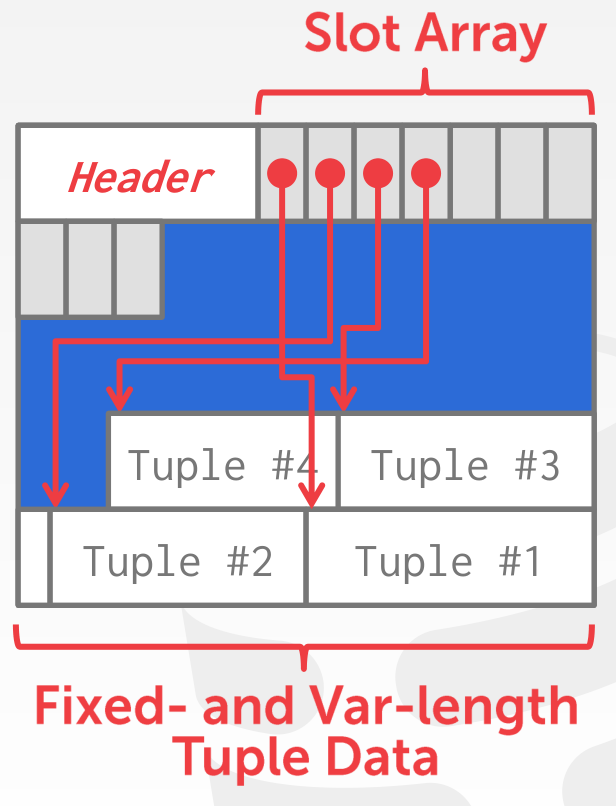
在每个 tuple 的开头处,会有一段 bitmap 指示该 tuple 的各字段是否为 null
例如,对于这样的 schema
CREATE TABLE heap_update (a INTEGER, b BIGINT, c CHAR(7), d DOUBLE, e VARCHAR(20), f FLOAT);插入三个 tuples 后,各字段的 offset 如下
[8067, 8071, 8079, 8086, 8094, 8109] - tuple3[8114, 8118, 8126, 8133, 8141, 8147] - tuple2[8152, 8156, 8164, 8171, 8179, 8188] - tuple1注意 tuple1 的 pageOffset 为 8151,这里存放了一个字节的 bitmap,所以其第一个字段的 offset 为 8152
各字段之间紧密排列,不存在 gap
tricky 的地方在于扩缩容,使用 deleteTupleDataRange 缩容,使用 insertTupleDataRange 扩容,注意扩容的变化
[tupDataStart, off) -> [tupDataStart - len, off - len)也就是扩容后新增的空间位于 [off - len, off)
需要手动维护 pageOffset,以便于在最后调用 computeValueOffsets 更新各字段的 offsets
同时,扩缩容也会修改 slot array,不必考虑 slot 的设置是否正确
其余 tuple 的
pageOffset可能随 slot 的设置动态变化,所以不必考虑
此时可以通过如下测试
testUpdatesNanoDB Buffer Management
主要考虑 page 和 tuple 的 pin 问题
DBPage 和 PageTuple 类均实现了 Pinnable 接口
其中对 PageTuple 的 pin 和 unpin 会影响包含该 tuple 的 DBPage
主要修改如下地方
HeapTupleFile.java
参考 getFirstTuple 方法,为 getTuple / getNextTuple / addTuple 方法添加 unpin page 调用
注意这里不必修改 updateTuple 和 deleteTuple 方法
HeapTupleFileManager.java
修改 openTupleFile 和 saveMetadata 方法,添加 unpin header page 调用
QueryEvaluator.java
在 process 前 pin tuple,在 process 后 unpin tuple
注意这里的 process 可能会调用 updateTuple 和 deleteTuple 方法,并且是唯一调用点,所以可以通过调用者来管理
SelectNode.java
其 getNextTuple 方法实现了 PlanNode 的 getNextTuple 方法
而 QueryEvaluator 在 executePlan 时会调用 getNextTuple 方法
SelectNode 的 getNextTuple 方法会调用 advanceCurrentTuple 获取新的 tuple,其实现会调用 getFirstTuple 和 getNextTuple 方法
而上文已经实现了 page 层面的 pin 和 unpin,所以感觉不必添加新的代码
实现之后,可以使用如下命令进行大规模测试
rm datafiles/*./nanodb < schemas/insert-perf/make-insperf.sql./nanodb < schemas/insert-perf/ins20k.sql若未实现,会报错 Not enough room to allocate a buffer of 8192 bytes!
可以在 sql 文件的 EXIT; 前添加 SHOW 'STORAGE' STATS;,以检查存储性能
NanoDB Storage Performance
初始性能
$ ./nanodb < schemas/insert-perf/ins20k.sqlstorage.pagesRead = 3306267storage.pagesWritten = 20000storage.fileChanges = 1storage.fileDistanceTraveled = 105144752StorageManager 通过 baseDir 构造 FileManager,再通过 FileManager 构造 BufferManager
FileManager 在 loadPage 和 savePage 时,会通过 updateFileIOPerfStats 更新统计数据
以 StorageManager 的 loadDBPage 为例,会调用 BufferManager 的 getPage,其中调用了 FileManager 的 loadPage
每一个 table 对应一个 DBFile,每一个 DBFile 包含多个 DBPage,第一个 page 为 HeaderPage,其余为 DataPage
以 heap tuple file 为例,HeaderPage 的布局如下
- file type
- page size
- schema size
- stats size
- schema
- stats
DataPage 的布局上面已经讲过了,其 header 只保存 slot number 信息
由于每次 insert tuple 时,都会从第一个 data page 开始,遍历每一个空间足够的 page 的每一个 slot
这里的所需的空间包括 tuple 的大小,并且假定需要分配新的 slot
所以时间效率较低,但空间效率极高
有一个非常简单的想法,考虑每次 insert tuple 时,都从最后一个 data page 开始,也就是 append-only
int pageNo = Math.max(1, dbFile.getNumPages() - 1);性能如下
storage.pagesRead = 20664storage.pagesWritten = 20000storage.fileChanges = 1storage.fileDistanceTraveled = 5312在 delete 操作较多时,会带来空间的浪费
突然发现
insert_perf.tbl的大小和ins20k.sql差不多
对于文件结构的优化,暂时没有什么思路
lab2

overview
SELECT * FROM test_simple_selects WHERE b < 25SelectCommand 为 QueryCommand 的子类
- 其
execute的第一步是prepareQueryPlan- 其中会根据
SelectClause计算 result schema- 更具体的,根据
FromClause计算 from schema - 检查 SELECT value 的引用是否存在,配合 from schema 构造 result schema
- 检查 WHERE / GROUP BY / HAVING / ORDER BY 中表达式的引用是否存在
- 目前暂不考虑处理 SELECT 中的子查询
- 更具体的,根据
- 获取 properties 中指定的 planner,并调用其
makePlan方法makePlan方法会继续调用makeSimpleSelect方法- 通过
FileScanNode构造PlanNode,并调用其prepare方法
- 通过
- 其中会根据
- 获取
TupleProcessor,这里对应为ResultCollector- 其余 DML 的对应为
TupleInserter / TupleUpdater / TupleRemover - 在
execute调用前就已经设置好了
- 其余 DML 的对应为
- 调用
QueryEvaluator.executePlan(plan, processor)- 调用
PlanNode的initialize方法 - 通过
PlanNode不断获取 next tuple,并使用TupleProcessor处理该 tuple
- 调用
features
- Basic
SELECTstatements that involve zero or more tables being joined together. (For example, “SELECT 3 + 2 AS five;” is a valid SQL query. The project plan-node is able to support situations where it has no child plan, and no expression references a column name.) Join predicates may appear in theWHEREclause, or in anONclause. - Basic joins using the “
SELECT ... FROM t1, t2, ...” syntax, as well as joins with anONclause. You do not need to supportNATURALjoins or joins with theUSINGclause in this planner (although this is available as an extra-credit task). - Left- and right-outer joins using the nested-loop join node (which you will work on in the next section). You do not need to support full-outer joins.
- Subqueries in the
FROMclause. - Grouping and aggregation, where both grouping attributes and aggregates may be expressions, and where a given
SELECTexpression may include multiple aggregate operations. You are encouraged to use the suppliedHashedGroupAggregateNodeclass. You will need to provide some limited validation of these expressions; details are given in a subsequent section. ORDER BYclauses, using the suppliededu.caltech.nanodb.plans.SortNodeclass.
paradigm
PlanNode plan = null;
if (FROM-clause is present) plan = generate_FROM_clause_plan();
if (WHERE-clause is present) plan = add_WHERE_clause_to(plan);
if (GROUP-BY-clause and/or HAVING-clause is present) plan = handle_grouping_and_aggregation(plan);
if (ORDER-BY-clause is present) plan = add_ORDER_BY_clause_to(plan);
// There's always a SELECT clause of some sort!plan = add_SELECT_clause_to(plan);note
记录了完成上述 features 的顺序
Projection
对应的测试用例 TestSelectProject
利用 ProjectNode 即可
在 SimplePlanner 类中保留 makeSimpleSelect 方法,完全重写 makePlan 方法
No FROM clause
对应的测试用例 TestSimpleFunctions
考虑构造 ProjectNode 时,sub plan 为 null 的情形即可
FROM clause subqueries
添加测试用例 TestFromSubquery,在 test_sql.props 中进行数据的定义和插入
将新增的测试用例归类为 hw2-self,注意修改 pom.xml
根据 FromClause 的类型判断是否存在子查询
递归调用 makePlan 后,利用 RenameNode 重命名为 alias name,即 AS 子句中的 table name
注意对于 FROM clause 而言
BASE_TABLE类型可能包含AS子句SELECT_SUBQUERY类型一定包含AS子句JOIN_EXPR类型一定不包含AS子句
下面解释使用 RenameNode 的必要性,考虑如下一个简单的查询
SELECT tmp.a FROM test_simple_selects AS tmp若不使用 RenameNode,则对应的查询计划为
Project[values: [tmp.a]] FileScan[table: test_simple_selects]在 ProjectNode prepare 的过程中,会在 FileScanNode 产生的 schema 中检查 tmp.a 的存在,而显然 schema 中只包含 test_simple_selects.a,所以会报错
而 RenameNode 在 prepare 的过程中,会修改自身 schema 的 table name 为 alias,所以可以通过 ProjectNode prepare 的检查,而其 getNextTuple 方法只是简单的调用 child 的 getNextTuple 方法
FROM clause join
添加测试用例 TestFromJoins
目前需要实现如下四种类型的 join
SELECT * FROM t1, t2 WHERE t1.a = t2.a- cross join with where clauseSELECT * FROM t1 JOIN t2 ON t1.a = t2.a- inner join with on exprSELECT * FROM t1 LEFT OUTER JOIN t2 ON t1.a = t2.a- left join with on exprSELECT * FROM t1 RIGHT OUTER JOIN t2 ON t1.a = t2.a- right join with on expr
在 makePlan 方法中,只需利用 NestedLoopJoinNode 即可
需要注意 join expr 的 child 的类型不一定是 BASE_TABLE,所以这里需要递归解析 FROM clause
关键在于 NestedLoopJoinNode 内部的实现,集中为 getTuplesToJoin 方法
首先在构造时,通过调用 swap 将 right outer join 化归为 left outer join
然后是 getTuplesToJoin 方法,思路如下
- 若 left table 为空,则直接 done,因为不可能为 right outer join
- 使用
leftTupleJoined字段标记当前的 left tuple 是否成功 join,在消耗完 right table 时,若没有成功 join,且 join 类型为 left outer join,则生成 dangling tuple,且 dangling tuple 无视 predicate 限制
ORDER BY clauses
添加测试用例 TestOrderBy
利用 SortNode 即可,注意 SortNode 内部的实现是预先排序好所有的 tuples,所以当 tuple 数量较多时,可能导致内存不足
Grouping and Aggregation
对应的测试用例如下
TestAggregationTestGroupByTestGroupingAndAggregationTestHaving
利用 Expression 类的 traverse 方法,收集 select value 和 having expression 中出现的 aggregate function,建立 String 到 FunctionCall 的映射,并将 expression 转换为 ColumnValue
只要 aggregates 或 groupByExprs 不为空,则利用 HashedGroupAggregateNode 构造 plan
若存在 havingExpr,则利用 PlanUtils.addPredicateToPlan 进行筛选
考虑如下的 table
| a | b | c |
|---|---|---|
| 1 | 1 | 5 |
| 1 | 2 | 6 |
| 2 | 3 | 8 |
| 2 | 4 | 12 |
执行如下查询
SELECT a, MAX(b) FROM test_having_more GROUP BY a HAVING SUM(c) < 15结果为 (1, 2)
执行计划如下
Explain Plan: Project[values: [test_having_more.a, MAX(test_having_more.b)]] cost is unknown SimpleFilter[pred: SUM(test_having_more.c) < 15] cost is unknown HashedGroupAggregate[groupBy=[test_having_more.a], aggregates={MAX(test_having_more.b)=MAX(test_having_more.b), SUM(test_having_more.c)=SUM(test_having_more.c)}] cost is unknown FileScan[table: test_having_more] cost is unknown
Plan cost is not available.主要关注 HashedGroupAggregate 计划节点
首先分析 prepare 的部分
使用 AggregationProcessor 收集的 aggregates 如下
MAX(test_having_more.b) -> {FunctionCall@6616} "MAX(test_having_more.b)"SUM(test_having_more.c) -> {FunctionCall@6761} "SUM(test_having_more.c)"
尽管收集 having expression 中出现的 aggregate function 在构造 HashedGroupAggregateNode 之后,但是因为是传引用,所以 prepare 的时候不会缺失 aggregates
在 HashedGroupAggregateNode prepare 的过程中,会调用 prepareSchemaStats 计算结果 schema,在这里就是
ColumnInfo[test_having_more.a:INTEGER]-groupByExprsColumnInfo[MAX(test_having_more.b):INTEGER]-aggregatesColumnInfo[SUM(test_having_more.c):INTEGER]-aggregates
注意计算 schema 的依据不是 select value
最后 ProjectNode prepare 的过程中,其 child 的 schema 就是上述 schema,将 expression 转换为 ColumnValue 后,MAX(test_having_more.b) 就可以找到对应的 ColumnInfo 了,否则就是在原始的 FunctionCall 上调用 getColumnInfo,其中是根据参数寻找 ColumnInfo 的,然而 test_having_more.b 并未出现在上述 schema 中,所以会报错
下面分析 executePlan 的部分
对于 HashedGroupAggregateNode,其 getNextTuple 会预先遍历所有的 tuples 并进行聚合,体现在 computeAggregates 方法中
- 获取一个 tuple,计算 group values
例如,对于 (1, 1, 5) 而言,其 group values 为 1
- 建立如下映射关系
group values -> (string -> function call)其中 string -> function call 就是传入的 aggregates
- 调用
updateAggregates,更新 aggregate function 的内部状态
此时 max = 1, sum = 5
- 如此反复,由于对于每一个 group values,其 aggregate function 都是独立的,所以最后的结果为
1 -> (max(b) = 2, sum(c) = 11)2 -> (max(b) = 4, sum(c) = 20)然后,以 group values 为 key,获取映射关系的迭代器,通过 generateOutputTuple 依次生成结果 (1, 2, 11), (2, 4, 20)
通过 SimpleFilterNode 过滤后,只剩下 (1, 2, 11)
最后,project 算子依据 select value 得到 (1, 2),这是因为其 schema 就是上述 schema,有相应的信息
可以分析得出,若 select value 中出现 group values 以外的非聚合值,则会报错,因为 schema 中没有对应的信息
LIMIT and OFFSET clauses
这是 Extra Credit,需要自己实现 LimitOffsetNode
添加测试用例 TestLimitOffset
注意默认的 limit 为 0,实现很简单
注意在 prepare 方法中需要根据 sub plan 初始化自身的状态
leftChild.prepare();schema = leftChild.getSchema();cost = leftChild.getCost();stats = leftChild.getStats();还需要覆盖 initialize 方法,防止进行 NestedLoopJoin 时 right child 为 LimitOffsetNode 需要重新初始化
在 makePlan 中,LIMIT 和 OFFSET clauses 在最后处理即可
lab3

Statistics Collection
需要统计的信息如下
file 级别
- The total number of tuples in the table file
- The average size of a tuple, in bytes
- The total number of data pages in the table file (for NanoDB heap files, this is just the total number of pages minus one, since only the header page is not a data page)
column 级别
- The total number of distinct values in that column, excluding
NULLvalues - The total number of
NULLvalues - The minimum and maximum value that appears in the column, but only if there are non-
NULLvalues, and if the column’s type is suitable for computing inequality-based selectivity estimates
通过手动执行 Analyze 命令收集统计数据,其 execute 方法会调用 HeapTupleFile 的 analyze 方法
通过 ColumnStatsCollector 类收集 column 级别的统计数据,便于在不同类型的 TupleFile 间复用
回忆统计信息存储在 HeaderPage 中
Plan Costing
ProjectNode
cost
若存在 sub plan,依据 numTuples 增加 cpuCost
若不存在,只有一个 tuple,猜测如下
// Estimated number of tuples: 1// Tuple size: 100// Estimated CPU cost: 1// Number of block IOs: 0// Number of large seeks: 0目前尚未调整 tupleSize
schema和stats
Select Value 有如下几种可能
*table.*columnexpression对于前三种,只要存在 sub plan,就可以提取相应的信息
对于最后一种,成功提取出 ColumnInfo 后,需要猜测 ColumnStats,目前只设置了 numUniqueValues
RenameNode
完全利用 sub plan 即可
SortNode
利用 sub plan,并依据 numTuples 增加 cpuCost,即排序的成本
HashedGroupAggregateNode
schema和stats
首先遍历 groupByExprs,这里只处理 expr 为 column 的情形
记录最终生成的 tuples 数量,需要每次累乘 column 的 numUniqueValues
同时修改该 column 的 stats,例如 numNullValues 必定属于 {-1, 0, 1}
可以这样思考,例如该 column 原来是
{1, 1, 4, 5, 1, 4, null, null},经过 group by 之后,变成了{1, 4, 5, null},只有numNullValues会发生变化
然后遍历 aggregates,根据 aggregate function 的返回值设置 ColumnInfo
并且生成新的 stats,目前只考虑 numUniqueValues
例如,若 aggregate function 为 MIN 或 MAX,那么有关系 numUniqueValues <= min(numUniqueValues, numTuples),其中 numTuples 为最终生成的 tuples 数量
例如该 column 原来是
{1, 2, 3, 4, 5, 5},若有幸每一行都单独为一个 group,那么numUniqueValues = 5,小于numTuples = 6
否则就乐观的认为 numUniqueValues 为为最终生成的 tuples 数量
cost
利用 sub plan,并依据 numTuples 增加 cpuCost,其中包括 hash 的成本和计算 aggregate function 的成本
并设置 numTuples 为最终生成的 tuples 数量
目前尚未调整 tupleSize
FileScanNode
根据 tupleFile 得到 schema 和 stats
注意这里的 stats 是 column 级别
file 级别的 stats 用于计算 cost
使用 StatisticsUpdater 更新 stats
SimpleFilterNode
利用 sub plan,并依据 numTuples 增加 cpuCost,同时根据选择率更新 numTuples
使用 StatisticsUpdater 更新 stats
NestedLoopJoinNode
schema和stats
利用 sub plan 进行简单的拼接
使用 StatisticsUpdater 更新 stats
cost
numTuples 为左右乘积,同时考虑选择率
tupleSize 为左右相加
cpuCost 的计算,考虑外层一次循环,内层 leftCost.numTuples 次循环,并考虑对 numTuples 个 pairs join 的成本
numBlockIOs 和 numLargeSeeks 的计算类似,此处无视了 buffer pool 的优化
Estimating Selectivity
集中在 SelectivityEstimator 类
需要支持如下的 predicates
- P1 AND P2 AND …
- P1 OR P2 OR …
- NOT P
- COLUMN = VALUE and COLUMN ≠ VALUE, for all column-types
- COLUMN ≥ VALUE and COLUMN < VALUE, for column-types that support the ratio-computation discussed earlier
- COLUMN ≤ VALUE and COLUMN > VALUE, for column-types that support the ratio-computation discussed earlier
- COLUMN_A = COLUMN_B and COLUMN_A ≠ COLUMN_B, for all column-types
前三种 predicates,使用如下公式递归计算内部的 predicates 即可
P(θ1 ∧ θ2 ∧ …) = P(θ1) × P(θ2) × P(…)P(θ1 ∨ θ2 ∨ …) = 1 – (1 – P(θ1)) × (1 – P(θ2)) × …P(¬θ) = 1 – P(θ)假设各个 predicates 之间是独立的
后四种 predicates 需要利用统计信息进行实际的计算
假设数据均匀分布
对于 = 和 ≠,需要了解 numUniqueValues,特别的,对于最后一种 predicate,参考如下内容
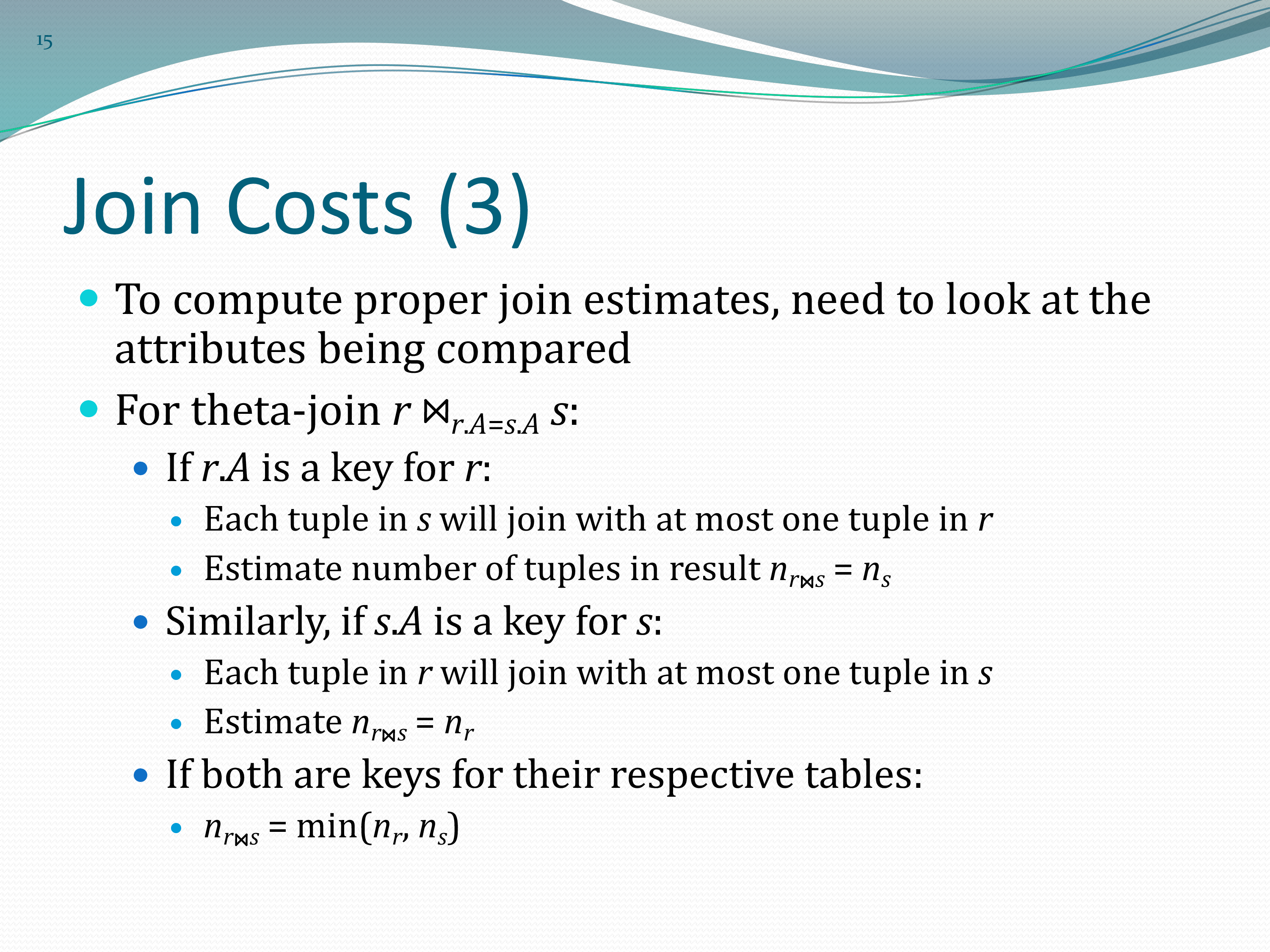
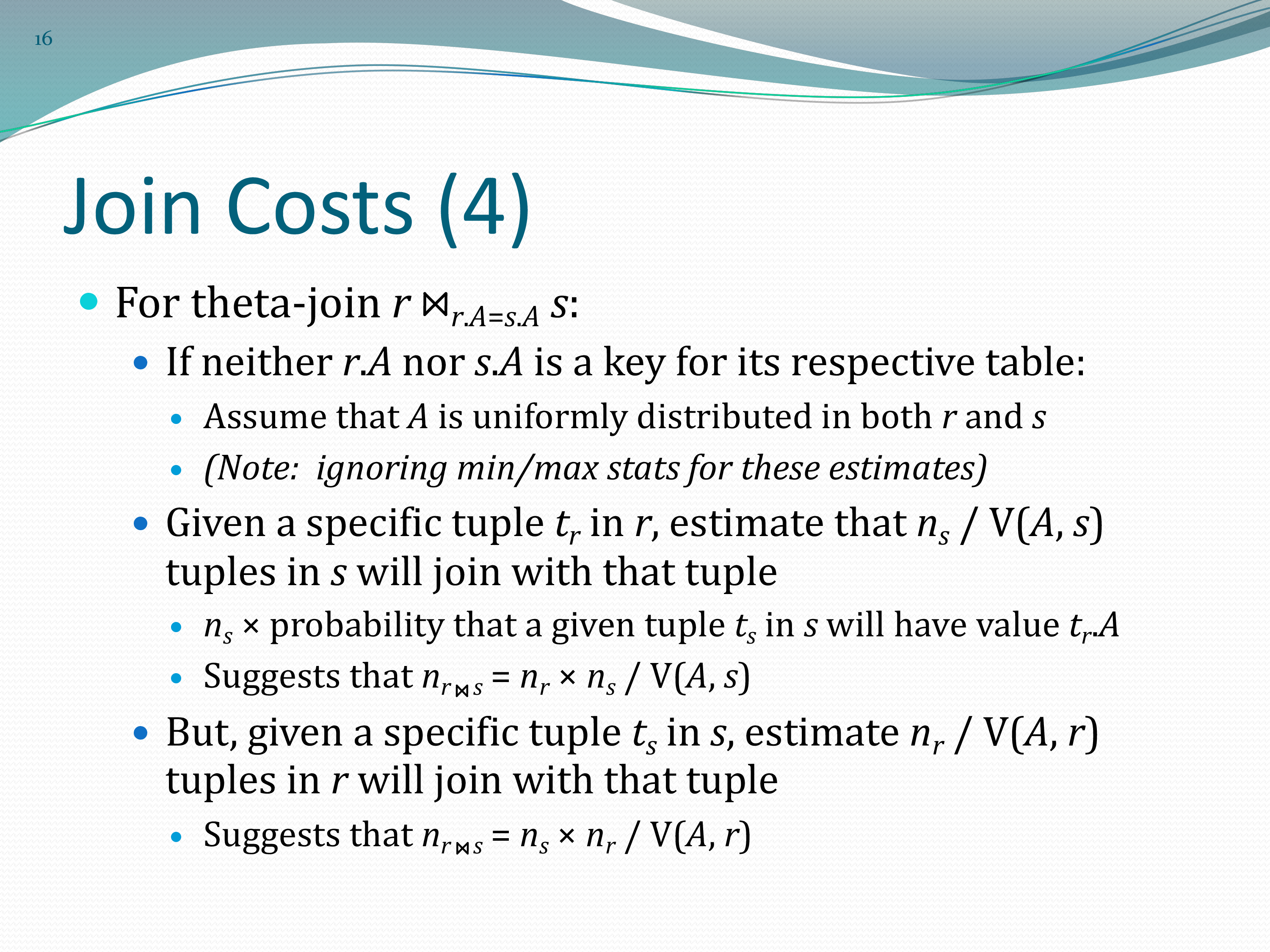
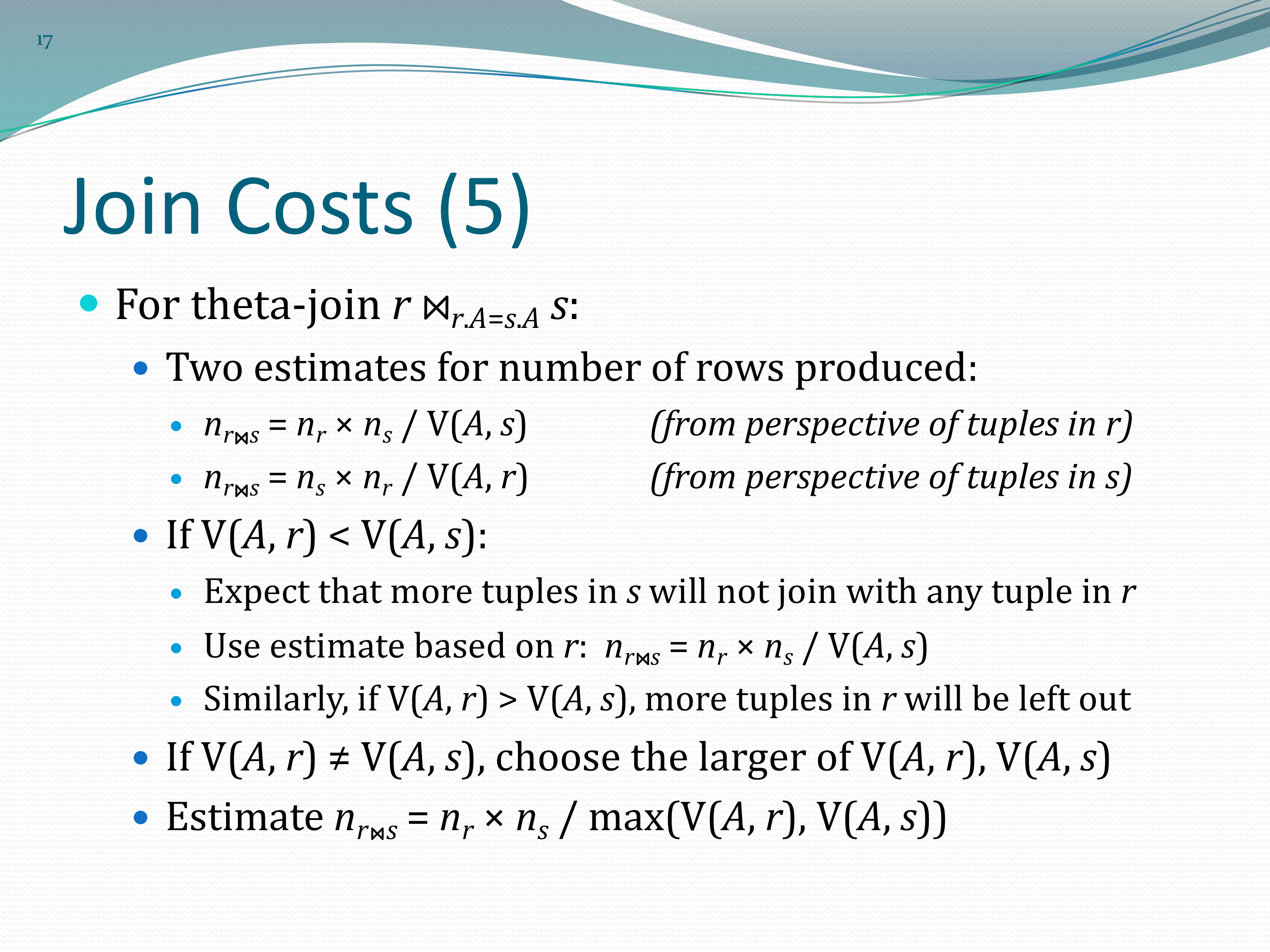
对于其余的比较,由于需要根据 minValue / maxValue / value 进行算术计算,所以仅支持数值类型
Estimating Plan-Node Column Statistics
集中在 StatisticsUpdater 类
需要支持如下的 predicates
- COLUMN op VALUE, where op is one of the following: =, ≠, >, ≥, <, ≤
- P1 AND P2 AND … - conjunctive selection predicate (the individual P1, P2, etc. are called “conjuncts”), although we will only use the conjuncts of the form COLUMN op VALUE
实际上只需要关注第一种 predicate
考虑到 AND 的累积效果
对于 =,置当前 column 的 numUniqueValues 和 numNullValues 属于 {-1, 0, 1},并置当前 column 的 minValue 和 maxValue 为 value
对应 ≠,感觉不必要更新
对于其余的比较,根据选择率,更新所有 columns 的 numUniqueValues 和 numNullValues,并更新当前 column 的 minValue 或 maxValue
Testing Plan Costing
Basic Plan Costs
会根据选择率计算产生的 tuples 数量
CMD> EXPLAIN SELECT * FROM cities;Explain Plan: LimitOffset[limit = 0, offset = 0] cost=[tuples=254.0, tupSize=23.8, cpuCost=508.0, blockIOs=1, largeSeeks=0] Project[values: [*]] cost=[tuples=254.0, tupSize=23.8, cpuCost=508.0, blockIOs=1, largeSeeks=0] FileScan[table: cities] cost=[tuples=254.0, tupSize=23.8, cpuCost=254.0, blockIOs=1, largeSeeks=0]
Estimated 254.000000 tuples with average size 23.787401Estimated number of block IOs: 1
CMD> EXPLAIN SELECT * FROM cities WHERE population > 1000000;Explain Plan: LimitOffset[limit = 0, offset = 0] cost=[tuples=225.6, tupSize=23.8, cpuCost=479.6, blockIOs=1, largeSeeks=0] Project[values: [*]] cost=[tuples=225.6, tupSize=23.8, cpuCost=479.6, blockIOs=1, largeSeeks=0] FileScan[table: cities, pred: cities.population > 1000000] cost=[tuples=225.6, tupSize=23.8, cpuCost=254.0, blockIOs=1, largeSeeks=0]
Estimated 225.582245 tuples with average size 23.787401Estimated number of block IOs: 1
CMD> EXPLAIN SELECT * FROM cities WHERE population > 5000000;Explain Plan: LimitOffset[limit = 0, offset = 0] cost=[tuples=99.3, tupSize=23.8, cpuCost=353.3, blockIOs=1, largeSeeks=0] Project[values: [*]] cost=[tuples=99.3, tupSize=23.8, cpuCost=353.3, blockIOs=1, largeSeeks=0] FileScan[table: cities, pred: cities.population > 5000000] cost=[tuples=99.3, tupSize=23.8, cpuCost=254.0, blockIOs=1, largeSeeks=0]
Estimated 99.262199 tuples with average size 23.787401Estimated number of block IOs: 1
CMD> EXPLAIN SELECT * FROM cities WHERE population > 8000000;Explain Plan: LimitOffset[limit = 0, offset = 0] cost=[tuples=4.5, tupSize=23.8, cpuCost=258.5, blockIOs=1, largeSeeks=0] Project[values: [*]] cost=[tuples=4.5, tupSize=23.8, cpuCost=258.5, blockIOs=1, largeSeeks=0] FileScan[table: cities, pred: cities.population > 8000000] cost=[tuples=4.5, tupSize=23.8, cpuCost=254.0, blockIOs=1, largeSeeks=0]
Estimated 4.522162 tuples with average size 23.787401Estimated number of block IOs: 1
CMD> SELECT * FROM cities WHERE population > 8000000;+---------+-----------+------------+----------+| city_id | city_name | population | state_id |+---------+-----------+------------+----------+| 1 | New York | 8143197 | 30 |+---------+-----------+------------+----------+
SELECT took 0.008139 sec to evaluate.Selected 1 rows.由于数据并非均匀分布,所以会产生误差
使用直方图
Costing Joins
考虑手动谓词下推带来的 cpu cost 的优化
CMD> EXPLAIN SELECT store_id FROM stores, cities > WHERE stores.city_id = cities.city_id AND cities.population > 1000000;Explain Plan: LimitOffset[limit = 0, offset = 0] cost=[tuples=1776.2, tupSize=36.8, cpuCost=1527776.3, blockIOs=2004, largeSeeks=0] Project[values: [stores.store_id]] cost=[tuples=1776.2, tupSize=36.8, cpuCost=1527776.3, blockIOs=2004, largeSeeks=0] SimpleFilter[pred: cities.city_id == stores.city_id AND cities.population > 1000000] cost=[tuples=1776.2, tupSize=36.8, cpuCost=1526000.0, blockIOs=2004, largeSeeks=0] NestedLoop[no pred] cost=[tuples=508000.0, tupSize=36.8, cpuCost=1018000.0, blockIOs=2004, largeSeeks=0] FileScan[table: stores] cost=[tuples=2000.0, tupSize=13.0, cpuCost=2000.0, blockIOs=4, largeSeeks=0] FileScan[table: cities] cost=[tuples=254.0, tupSize=23.8, cpuCost=254.0, blockIOs=1, largeSeeks=0]
Estimated 1776.238159 tuples with average size 36.787399Estimated number of block IOs: 2004
CMD> EXPLAIN SELECT store_id > FROM stores JOIN > (SELECT city_id FROM cities > WHERE population > 1000000) AS big_cities > ON stores.city_id = big_cities.city_id;Explain Plan: LimitOffset[limit = 0, offset = 0] cost=[tuples=1776.2, tupSize=36.8, cpuCost=1414105.3, blockIOs=2004, largeSeeks=0] Project[values: [stores.store_id]] cost=[tuples=1776.2, tupSize=36.8, cpuCost=1414105.3, blockIOs=2004, largeSeeks=0] NestedLoop[pred: big_cities.city_id == stores.city_id] cost=[tuples=1776.2, tupSize=36.8, cpuCost=1412329.0, blockIOs=2004, largeSeeks=0] FileScan[table: stores] cost=[tuples=2000.0, tupSize=13.0, cpuCost=2000.0, blockIOs=4, largeSeeks=0] Rename[resultTableName=big_cities] cost=[tuples=225.6, tupSize=23.8, cpuCost=479.6, blockIOs=1, largeSeeks=0] LimitOffset[limit = 0, offset = 0] cost=[tuples=225.6, tupSize=23.8, cpuCost=479.6, blockIOs=1, largeSeeks=0] Project[values: [cities.city_id]] cost=[tuples=225.6, tupSize=23.8, cpuCost=479.6, blockIOs=1, largeSeeks=0] FileScan[table: cities, pred: cities.population > 1000000] cost=[tuples=225.6, tupSize=23.8, cpuCost=254.0, blockIOs=1, largeSeeks=0]
Estimated 1776.238159 tuples with average size 36.787399Estimated number of block IOs: 2004Updating Column Statistics
下面的例子反映了选择率的计算和列统计信息的更新之间的关系
CMD> EXPLAIN SELECT * FROM cities WHERE city_id > 20 AND city_id < 200;Explain Plan: LimitOffset[limit = 0, offset = 0] cost=[tuples=184.8, tupSize=23.8, cpuCost=438.8, blockIOs=1, largeSeeks=0] Project[values: [*]] cost=[tuples=184.8, tupSize=23.8, cpuCost=438.8, blockIOs=1, largeSeeks=0] FileScan[table: cities, pred: cities.city_id > 20 AND cities.city_id < 200] cost=[tuples=184.8, tupSize=23.8, cpuCost=254.0, blockIOs=1, largeSeeks=0]
Estimated 184.782822 tuples with average size 23.787401Estimated number of block IOs: 1
CMD> EXPLAIN SELECT * FROM ( > SELECT * FROM cities WHERE city_id > 20) t > WHERE city_id < 200;Explain Plan: LimitOffset[limit = 0, offset = 0] cost=[tuples=180.7, tupSize=23.8, cpuCost=904.6, blockIOs=1, largeSeeks=0] Project[values: [*]] cost=[tuples=180.7, tupSize=23.8, cpuCost=904.6, blockIOs=1, largeSeeks=0] SimpleFilter[pred: t.city_id < 200] cost=[tuples=180.7, tupSize=23.8, cpuCost=723.8, blockIOs=1, largeSeeks=0] Rename[resultTableName=t] cost=[tuples=234.9, tupSize=23.8, cpuCost=488.9, blockIOs=1, largeSeeks=0] LimitOffset[limit = 0, offset = 0] cost=[tuples=234.9, tupSize=23.8, cpuCost=488.9, blockIOs=1, largeSeeks=0] Project[values: [*]] cost=[tuples=234.9, tupSize=23.8, cpuCost=488.9, blockIOs=1, largeSeeks=0] FileScan[table: cities, pred: cities.city_id > 20] cost=[tuples=234.9, tupSize=23.8, cpuCost=254.0, blockIOs=1, largeSeeks=0]
Estimated 180.711456 tuples with average size 23.787401Estimated number of block IOs: 1
CMD> EXPLAIN SELECT * FROM ( > SELECT * FROM cities WHERE city_id < 200) t > WHERE city_id > 20;Explain Plan: LimitOffset[limit = 0, offset = 0] cost=[tuples=180.7, tupSize=23.8, cpuCost=834.3, blockIOs=1, largeSeeks=0] Project[values: [*]] cost=[tuples=180.7, tupSize=23.8, cpuCost=834.3, blockIOs=1, largeSeeks=0] SimpleFilter[pred: t.city_id > 20] cost=[tuples=180.7, tupSize=23.8, cpuCost=653.6, blockIOs=1, largeSeeks=0] Rename[resultTableName=t] cost=[tuples=199.8, tupSize=23.8, cpuCost=453.8, blockIOs=1, largeSeeks=0] LimitOffset[limit = 0, offset = 0] cost=[tuples=199.8, tupSize=23.8, cpuCost=453.8, blockIOs=1, largeSeeks=0] Project[values: [*]] cost=[tuples=199.8, tupSize=23.8, cpuCost=453.8, blockIOs=1, largeSeeks=0] FileScan[table: cities, pred: cities.city_id < 200] cost=[tuples=199.8, tupSize=23.8, cpuCost=254.0, blockIOs=1, largeSeeks=0]
Estimated 180.711456 tuples with average size 23.787401Estimated number of block IOs: 1考虑后面两个查询,由于第一次过滤出 tuples 数量的不同,导致最终的 cpu cost 会有所不同,因为 ProjectNode 和 SimpleFilterNode 都会增加 numTuples 单位的 cpu cost
另外,这两个查询的 numTuples 是一致的,分析如下
在实际的数据中,city_id 在 [1, 254] 之间均匀分布
考虑第二个查询
- 第一次过滤,选择率为
(254 - 20) / (254 - 1) = 0.92,过滤出 tuples 数量为254 * 0.92 = 234.9,更新列统计信息 - 第二次过滤,选择率为
1 - (254 - 200) / (254 - 20) = 0.77,过滤出 tuples 数量为234.9 * 0.77 = 180.8
考虑第三个查询
- 第一次过滤,选择率为
1 - (254 - 200) / (254 - 1) = 0.79,过滤出 tuples 数量为254 * 0.79 = 200.6,更新列统计信息 - 第二次过滤,选择率为
(200 - 20) / (200 - 1) = 0.90,过滤出 tuples 数量为200.6 * 0.90 = 180.5
用公式应该不难推导出来
numTuples是一致的
由于两次过滤出现在不同 plan node 中,导致均匀的度量在两次过滤中是不一致的
例如第二个查询的第一次过滤,假设是数据在 [1, 254] 之间均匀分布,而更新列统计信息后,假设就变成了数据在 [20, 254] 之间均匀分布
所以后面两个查询过滤出 tuples 数量和第一个查询是不一致的,若不更新列统计信息,就一致了
Extra Credit
TODO
lab4

overview
以 cpu cost 为依据,使用动态规划的思路,优化 join 操作
首先定义 leaf plans,leaf plans 包括
BASE_TABLESELECT_SUBQUERYLEFT_OUTER和RIGHT_OUTER
注意这里视外连接为 leaf plan,是因为外连接没有一些良好的性质,例如,对于 inner join 或 cross join 而言,是满足交换律和结合律的
E1 ⋈ E2 ≡ E2 ⋈ E1E1 ⋈ (E2 ⋈ E3) ≡ (E1 ⋈ E2) ⋈ E3此处无视 schema 的乱序
然而,对于外连接而言,这些都不满足,以左外连接为例
E1 ⟕ E2 ≢ (E2 ⟕ E1)(E1 ⟕ E2) ⟕ E3 ≢ E1 ⟕ (E2 ⟕ E3)考虑外连接的悬浮元组,一旦 outer 侧的 table 不一样,结果就可能不同
然后,我们需要限制能够优化的 predicates,类似上个实验中更新列统计信息,这里只能尝试优化 conjunctive selection predicate,也就是 P1 AND P2 AND ... 的形式
动态规划的思路如下
-
解析整个 from 子句,提取出 leaf plans 和 conjuncts
- 例如,对于
SELECT * FROM t1, t2 WHERE t1.a = t2.a AND t2.b > 5;,就可以得到两个 leaf plans 和两个 conjuncts - 这里需要拆分
t1.a = t2.a AND t2.b > 5为两个 conjuncts
- 例如,对于
-
为 leaf plans 制定查询计划,同时尽可能的下推 conjuncts
- 这里下推谓词的依据是,最终 plan 得到的 schema 能够解析 conjuncts 中的所有符号
- 例如
FileScan[table: t2]能够解析t2.b > 5而不能解析t1.a = t2.a - 另外,对于外连接而言,还需要保证 conjuncts 作用的 table 为 outer 侧
- 这是因为
σθ1(E1 ⟕ E2) ≡ σθ1(E1) ⟕ E2,而σθ2(E1 ⟕ E2) ≢ E1 ⟕ σθ2(E2) - 这一点看上去并不平凡,大概与 null 值相关
-
为了减少搜索空间,在动态规划时只考虑 left-deep join trees,也就是 leaf plans 总作为 right table
- 同时每生成一个新的 plan,都要尽可能的下推 conjuncts,这里 conjuncts 不包括 child plan 已经应用的
- 这可以保证最终的 plan 可以应用全部的 conjuncts
下面举一个例子阐释动态规划的过程,假设有三个 leaf plans,暂不考虑 conjuncts
[1] [2] [3]第一轮以 [1] 为 left table,得到
[1, 2] [1, 3]然后以 [2] 为 left table,需要比较 [2, 1] 和 [1, 2] 的成本,假设这里 [2, 1] 成本更低,得到
[2, 1] [1, 3] [2, 3]然后以 [3] 为 left table 类似上述过程,最终假设结果如下
[2, 1] [3, 1] [2, 3]然后开始第二轮,需要比较 [2, 1, 3] / [3, 1, 2] / [2, 3, 1] 之间的成本,得到最终的 plan
implementation
在新的 planner 类 CostBasedJoinPlanner 中完成所有工作
由于 CostBasedJoinPlanner 只会优化 from 和 where 子句中的内容,所以需要从 SimplePlanner 中抽象出一些共同的方法,放置在抽象类 AbstractPlannerImpl 中
需要定义一个数据结构维护动态规划过程中产生的中间结果,即 JoinComponent,其中包含了
- 实际的执行计划 join plan
- 该执行计划所使用的 leaf plans
- 该执行计划所使用的 conjuncts
那么,对于每一轮,只需维护如下的数据结构即可
leaf plans -> join component其中 leaf plans 即为 join component 中的 leaf plans
根据动态规划的思路,实现下面三个方法
- Collecting Details from the FromClause - 对应
collectDetails方法 - Generating Optimal Leaf-Plans - 对应
generateLeafJoinComponents方法 - Generating an Optimal Join Plan - 对应
generateOptimalJoin方法
makeJoinPlan 方法中调用了上述三个方法,为 from 和 where 子句生成执行计划
test
考虑如下的三表连接
EXPLAIN SELECT store_id, property_costsFROM stores, cities, statesWHERE stores.city_id = cities.city_id AND cities.state_id = states.state_id AND state_name = 'Oregon' AND property_costs > 500000;改写为
EXPLAIN SELECT store_id, property_costs FROMstores JOIN citiesON stores.city_id = cities.city_id AND property_costs > 500000JOIN statesON cities.state_id = states.state_id AND state_name = 'Oregon';或
EXPLAIN SELECT store_id, property_costs FROMstores JOIN citiesON stores.city_id = cities.city_id AND property_costs > 500000CROSS JOIN statesWHERE cities.state_id = states.state_id AND state_name = 'Oregon';其结果均为
Explain Plan: LimitOffset[limit = 0, offset = 0] cost=[tuples=19.6, tupSize=52.5, cpuCost=20744.2, blockIOs=21, largeSeeks=0] Project[values: [stores.store_id, stores.property_costs]] cost=[tuples=19.6, tupSize=52.5, cpuCost=20744.2, blockIOs=21, largeSeeks=0] SimpleFilter[pred: cities.city_id == stores.city_id AND property_costs > 500000] cost=[tuples=19.6, tupSize=52.5, cpuCost=20724.6, blockIOs=21, largeSeeks=0] NestedLoop[no pred] cost=[tuples=4975.4, tupSize=52.5, cpuCost=15749.2, blockIOs=21, largeSeeks=0] SimpleFilter[pred: cities.state_id == states.state_id] cost=[tuples=5.0, tupSize=39.5, cpuCost=813.0, blockIOs=2, largeSeeks=0] NestedLoop[no pred] cost=[tuples=254.0, tupSize=39.5, cpuCost=559.0, blockIOs=2, largeSeeks=0] FileScan[table: states, pred: states.state_name == 'Oregon'] cost=[tuples=1.0, tupSize=15.7, cpuCost=51.0, blockIOs=1, largeSeeks=0] FileScan[table: cities] cost=[tuples=254.0, tupSize=23.8, cpuCost=254.0, blockIOs=1, largeSeeks=0] FileScan[table: stores, pred: property_costs > 500000] cost=[tuples=999.0, tupSize=13.0, cpuCost=2000.0, blockIOs=4, largeSeeks=0]
Estimated 19.588217 tuples with average size 52.454067Estimated number of block IOs: 21另外,在测试中发现了一个问题,由于在动态规划的过程中并非考虑 schema 的乱序问题,所以之前的某些 select value 为 * 的 SQL 测试将无法通过
例如,对于如下查询,最终生成执行计划的 schema 可能并不是按照 [1, 2, 3] 的顺序
SELECT * FROM t1, t2, t3一种思路是,在用户层显式的指定一个顺序
SELECT t1.*, t2.*, t3.* FROM t1, t2, t3还有一种思路是,使用 SimplePlanner 得到正确的 schema 后,显式的修改 ProjectNode 中的 inputSchema,不过设计文档中指出并不需要实现这个 functionality,所以就无所谓了
lab5

需要实现 SELECT / WHERE / HAVING 子句中的 subquery
这些子查询实际上都是 SubqueryOperator,有三个子类
ScalarSubqueryInSubqueryOperatorExistsOperator
这些 operator 内部的 evaluate 方法实现起来很简单,就是初始化 subquery plan,然后根据具体的语义处理
每次 evaluate 时都会重新初始化 subquery plan,在某些情形下可以优化
Planning Subqueries
首先需要为这些子查询制定查询计划
为此需要添加 ExpressionPlanner,实现 ExpressionProcessor 的接口
对 SELECT / WHERE / HAVING 子句中的 expr 进行 traverse
若遇到 expr 为 SubqueryOperator,则提取 subquery,并递归调用 makePlan
同时需要在恰当的位置进行 prepare,因为这些 subquery plan 与 plan 之间没有直接关联
完成之后就可以实现不相关子查询
Costing Expressions with Subqueries
因为 expr 中可能出现子查询,为此需要更新部分 plan node 的代价估计
在之间的估计中,per-row cpu cost 为 1,即处理一个 tuple 的 cpu cost,现在需要根据表达式的复杂度估计 per-row cpu cost
简单的模型如下
- 在对 expr 进行 traverse 的过程中,每一次 enter,若 expr 不是 subquery,则 cpu cost 加 1
- 否则 cpu cost 加 subquery 的 cost cpu
这依赖于在 plan prepare 前,所有的 subquery plan 已经 prepare 了
具体实现由 ExpressionCostCalculator 完成
下面看一些具体的例子,其中 test_exists_1 共有 4 行
- select subquery
CMD> explain select a from test_exists_1;Explain Plan: LimitOffset[limit = 0, offset = 0] cost=[tuples=4.0, tupSize=5.0, cpuCost=8.0, blockIOs=1, largeSeeks=0] Project[values: [test_exists_1.a]] cost=[tuples=4.0, tupSize=5.0, cpuCost=8.0, blockIOs=1, largeSeeks=0] FileScan[table: test_exists_1] cost=[tuples=4.0, tupSize=5.0, cpuCost=4.0, blockIOs=1, largeSeeks=0]
Estimated 4.000000 tuples with average size 5.000000Estimated number of block IOs: 1
CMD> explain select a + 1 from test_exists_1;Explain Plan: LimitOffset[limit = 0, offset = 0] cost=[tuples=4.0, tupSize=5.0, cpuCost=16.0, blockIOs=1, largeSeeks=0] Project[values: [test_exists_1.a + 1]] cost=[tuples=4.0, tupSize=5.0, cpuCost=16.0, blockIOs=1, largeSeeks=0] FileScan[table: test_exists_1] cost=[tuples=4.0, tupSize=5.0, cpuCost=4.0, blockIOs=1, largeSeeks=0]
Estimated 4.000000 tuples with average size 5.000000Estimated number of block IOs: 1
CMD> explain select a, a + 1 from test_exists_1;Explain Plan: LimitOffset[limit = 0, offset = 0] cost=[tuples=4.0, tupSize=5.0, cpuCost=20.0, blockIOs=1, largeSeeks=0] Project[values: [test_exists_1.a, test_exists_1.a + 1]] cost=[tuples=4.0, tupSize=5.0, cpuCost=20.0, blockIOs=1, largeSeeks=0] FileScan[table: test_exists_1] cost=[tuples=4.0, tupSize=5.0, cpuCost=4.0, blockIOs=1, largeSeeks=0]
Estimated 4.000000 tuples with average size 5.000000Estimated number of block IOs: 1
CMD> explain select (select a from test_exists_1) from test_exists_1;Explain Plan: LimitOffset[limit = 0, offset = 0] cost=[tuples=4.0, tupSize=5.0, cpuCost=36.0, blockIOs=1, largeSeeks=0] Project[values: [SelectClause[id=109069556 values=[test_exists_1.a] from=JoinClause[type=BASE_TABLE, table=test_exists_1]]]] cost=[tuples=4.0, tupSize=5.0, cpuCost=36.0, blockIOs=1, largeSeeks=0] FileScan[table: test_exists_1] cost=[tuples=4.0, tupSize=5.0, cpuCost=4.0, blockIOs=1, largeSeeks=0]
Estimated 4.000000 tuples with average size 5.000000Estimated number of block IOs: 1(a, a + 1) -> 20 = 4 + 4 * (1 + 3)
(select a from test_exists_1) -> 36 = 4 + 4 * 8
- 与 from subquery 比较
CMD> explain select a from (select a from test_exists_1) as tmp;Explain Plan: LimitOffset[limit = 0, offset = 0] cost=[tuples=4.0, tupSize=5.0, cpuCost=12.0, blockIOs=1, largeSeeks=0] Project[values: [tmp.a]] cost=[tuples=4.0, tupSize=5.0, cpuCost=12.0, blockIOs=1, largeSeeks=0] Rename[resultTableName=tmp] cost=[tuples=4.0, tupSize=5.0, cpuCost=8.0, blockIOs=1, largeSeeks=0] LimitOffset[limit = 0, offset = 0] cost=[tuples=4.0, tupSize=5.0, cpuCost=8.0, blockIOs=1, largeSeeks=0] Project[values: [test_exists_1.a]] cost=[tuples=4.0, tupSize=5.0, cpuCost=8.0, blockIOs=1, largeSeeks=0] FileScan[table: test_exists_1] cost=[tuples=4.0, tupSize=5.0, cpuCost=4.0, blockIOs=1, largeSeeks=0]
Estimated 4.000000 tuples with average size 5.000000Estimated number of block IOs: 1相较于最基础的查询,仅仅多了一次 projection 的开销
- where subquery
CMD> EXPLAIN SELECT a FROM test_exists_1 WHERE a = 1;Explain Plan: LimitOffset[limit = 0, offset = 0] cost=[tuples=1.0, tupSize=5.0, cpuCost=13.0, blockIOs=1, largeSeeks=0] Project[values: [test_exists_1.a]] cost=[tuples=1.0, tupSize=5.0, cpuCost=13.0, blockIOs=1, largeSeeks=0] FileScan[table: test_exists_1, pred: test_exists_1.a == 1] cost=[tuples=1.0, tupSize=5.0, cpuCost=12.0, blockIOs=1, largeSeeks=0]
Estimated 1.000000 tuples with average size 5.000000Estimated number of block IOs: 1
CMD> EXPLAIN SELECT a FROM test_exists_1 WHERE (SELECT b FROM test_exists_2 WHERE b = 40) = 40;Explain Plan: LimitOffset[limit = 0, offset = 0] cost=[tuples=1.0, tupSize=5.0, cpuCost=61.0, blockIOs=1, largeSeeks=0] Project[values: [test_exists_1.a]] cost=[tuples=1.0, tupSize=5.0, cpuCost=61.0, blockIOs=1, largeSeeks=0] FileScan[table: test_exists_1, pred: (SelectClause[id=973936431 values=[test_exists_2.b] from=JoinClause[type=BASE_TABLE, table=test_exists_2] where=test_exists_2.b == 40]) == 40] cost=[tuples=1.0, tupSize=5.0, cpuCost=60.0, blockIOs=1, largeSeeks=0]
Estimated 1.000000 tuples with average size 5.000000Estimated number of block IOs: 161 = 1 + 4 * (13 + 1 + 1)
Correlated Evaluation
非常 tricky 的一个地方
实验指南的大概意思是,在为子查询制定查询计划时,其发起方当前的 plan env 就是该子查询 env 的 parent env
例如,对于 where sub query,在 CostBasedJoinPlanner 的框架下,其 parent env 就是 SelectNode 或 NestedLoopJoinNode 的 env
理想情形下,由于相关,所以 parent 在处理 from 子句后,总会剩下 predicate 无法被应用,该 predicate 就会转化为
SimpleFilterNode或包含在FileScanNode中但在某些情形中,由于对
correlatedWith信息的获取存在问题在
pushConjunctsDown中就会提前应用 predicate,所以此时可能 parent env 应用在了RenameNode上,就会出现问题对于
SimplePlanner就不存在相关的问题,因为对 predicate 的处理在 rename 之后
这样,当 sub query 进行 evaluate 时,就可以保证在 parent env 中对应的 tuple 已经准备好了
对于 where sub query,观察
isTupleSelected或canJoinTuples对于 select sub query,观察
projectTuple对于 having sub query,观察
computeAggregates目前主要考虑的是 where 子句中出现的相关子查询,对于其余形式尚未进行测试
为此,每一种 sub query (select / where / having) 都需要单独构造 expression-planner,其中会初始化一个新的 env,该 expression-planner 遇到的所有子查询都以该 env 为 parent env,具体的,该子查询对应 plan 的所有 plan node 都以该 env 为 parent env
之后,设置发起方当前的 plan env 为 expression-planner 中的 env
还有一个问题是选择率的估计,注意到相关的代码并未考虑 env,所以即使 env 准备好了,选择率的估计中也不会考虑 parent 的 schema,所以只能返回默认的选择率
这里涉及到在何处对 sub query 进行 prepare,目前的考虑是在发起方设置当前的 plan env 后
另外,代码中并未使用参数 List<SelectClause> enclosingSelects,具体的注释如下
a list of enclosing queries, if selClause is a nested subquery. This is allowed to be an empty list, or null, if the query is a top-level query. If selClause is a nested subquery, enclosingSelects[0] is the outermost enclosing query, then enclosingSelects[1] is enclosed by enclosingSelects[0], and so forth. The most tightly enclosing query is the last one in enclosingSelects.enclosing 是外围的意思,但感觉 parent env 机制已经足够支持相关子查询
下面是分析,以 CostBasedJoinPlanner 为例
CREATE TABLE test_ecn_t1 ( a_id INTEGER);INSERT INTO test_ecn_t1 VALUES (1);INSERT INTO test_ecn_t1 VALUES (2);
CREATE TABLE test_ecn_t2 ( b_id INTEGER);INSERT INTO test_ecn_t2 VALUES (2);INSERT INTO test_ecn_t2 VALUES (3);
CREATE TABLE test_ecn_t3 ( id INTEGER, a_pid INTEGER, b_pid INTEGER);INSERT INTO test_ecn_t3 VALUES (2048, 0, 1);INSERT INTO test_ecn_t3 VALUES (2049, 1, 2);
select a_id from test_ecn_t1 where exists (select * from test_ecn_t2 where exists (select * from test_ecn_t3 where a_pid + 1 = a_id and b_pid + 1 = b_id))首先是 plan 的构造
-
最内层就是处理
select * from test_ecn_t3 where a_pid + 1 = a_id and b_pid + 1 = b_id -
最内层 plan 构造完成,即中间层 plan 的 where sub query 构造完成
为最内层所有 plan node 添加 parent env (7925)
处理 from 子句,并设置 file scan node 的 env 为 7925
- 中间层 plan 构造完成,即最外层 plan 的 where sub query 构造完成
为中间层所有 plan node 添加 parent env (8257)
注意这里包含了之前的 file scan node
处理 from 子句,并设置 file scan node 的 env 为 8257
- 最外层 plan 构造完成
然后是 plan 的执行
- 最外层在 file scan node 中获取 tuple 为 [1],置入 env (6517)
- env 编号发生了变化,可能进行了垃圾回收
- 求值最外层的 exists,执行中间层 plan
- 中间层在 file scan node 中获取 tuple 为 [2],置入 env (6674)
- 注意其 parent env 为 6517
- 求值中间层的 exists,执行最内层 plan
- 最内层 plan 在 file scan node 中获取 tuple 为 [2048, 0, 1],置入 env (6827)
- 注意其 parent env 为 6674
- 于是 env 链成功构造
Test
- 发现 ORDER BY 子句中出现的 symbol 必须出现在 select value 中
观察 prepareQueryPlan 中的 computeSchema 方法
所以 ORDER BY 子句中不能出现 aggregation
- ScalarSubquery 有且仅能生成一个 tuple,且该 tuple 只能包含一个 column
CREATE TABLE test_exists_1 ( a INTEGER );CREATE TABLE test_exists_2 ( b INTEGER );INSERT INTO test_exists_1 VALUES (1);INSERT INTO test_exists_1 VALUES (2);INSERT INTO test_exists_1 VALUES (3);INSERT INTO test_exists_1 VALUES (4);INSERT INTO test_exists_2 VALUES (30);INSERT INTO test_exists_2 VALUES (40);INSERT INTO test_exists_2 VALUES (50);INSERT INTO test_exists_2 VALUES (60);SELECT * FROM test_exists_1 WHERE (SELECT b, b + 5 AS c FROM test_exists_2 WHERE b = 50);SELECT * FROM test_exists_1 WHERE (SELECT b FROM test_exists_2 WHERE b > 100);SELECT * FROM test_exists_1 WHERE (SELECT b FROM test_exists_2);和 sqlite3 的语义有略微不同,其结果分别是
- sub-select returns 2 columns - expected 1
- empty 则认为是 false,无结果
- empty 则认为是 true,等价于
SELECT * FROM test_exists_1
修改了测试用例中关于异常类的判定,应为 ExpressionException 而非 ExecutionException
Extra Credit
-
CostBasedJoinPlanner和SimplePlanner均可通过目前所有的测试用例 - 需要支持 ON 子句中的 subquery,目前只考虑
CostBasedJoinPlanner
注意到 ON 子句中的 subquery 并未标记 correlatedWith 信息
未在
computeSchema中对 ON 子句调用resolveExpressionRefs
所以在 pushConjunctsDown 中会错误的应用无法解析的 predicate
- 不相关子查询使用
MaterializeNode缓存行 - Decorrelating Queries
需要变换 AST,并实现 Semijoin 和 Anti-Semijoin 操作,以消解相关子查询
例如,对于
SELECT ... FROM t1 ... WHERE EXISTS (SELECT ... FROM t2 WHERE a = t1.b);可以变换为
SELECT ... FROM (t1 ...) LEFT SEMIJOIN (SELECT ... FROM t2) ON t2.a = t1.b;若为 NOT EXISTS,使用 Anti-Semijoin 即可
lab6

对应的课件
可视化参考
Complete Missing B+ Tree Operations
quick start
Header Page 存储布局
- file type
- page size
- root page no
- first leaf page no
- first empty page no
- schema size
- stats size
- schema
- stats
Inner Page 存储布局
- file type
- page size
- next page no (for empty page)
- the number of pointers
- first pointer
对于 key 和 pointer 的布局,可以参考
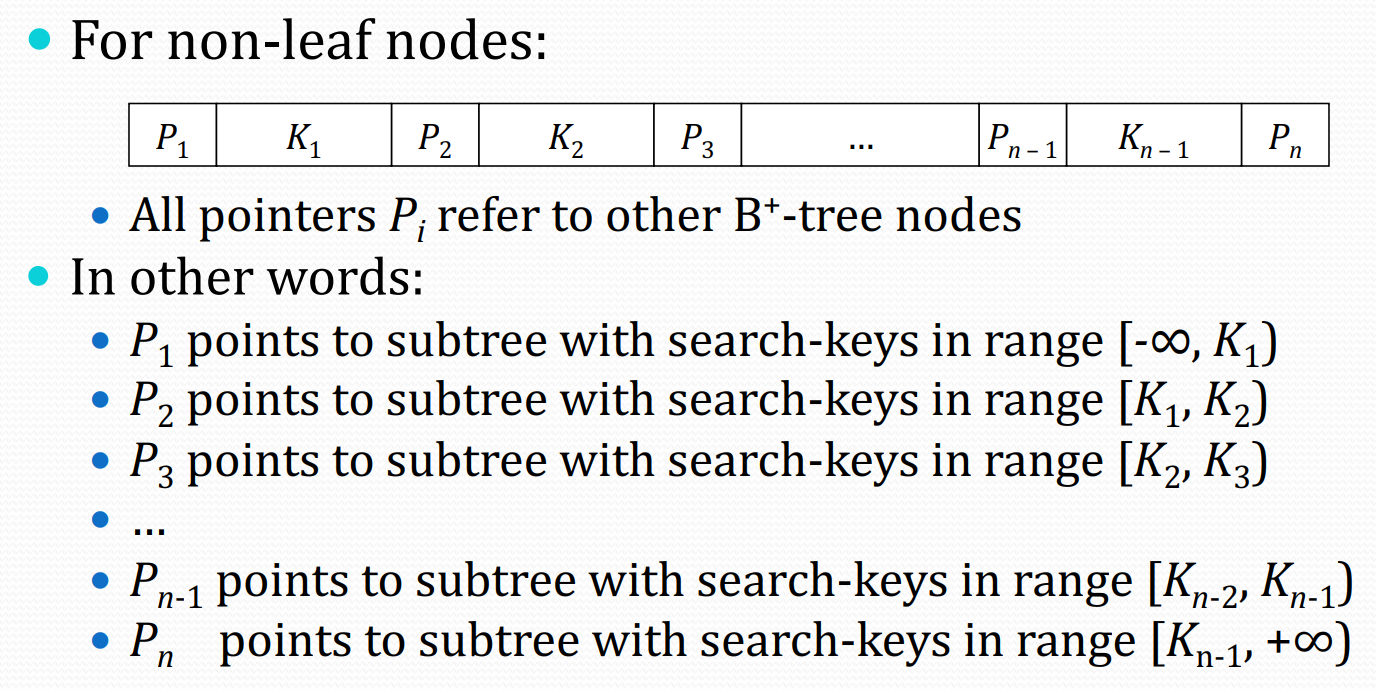
即对于一个 pointer 而言,左侧 <,右侧 ≥
Leaf Page 存储布局
- file type
- page size
- next leaf page no (for leaf page) or next page no (for empty page)
- the number of tuples
- first tuple
tuple 有序排列,其内部布局仍由 PageTuple 管理
Leaf Page 和 Inner Page 均为 Data Page,且均可能成为 Root Page
对应的类从原始页中提取并缓存相关信息,使用 loadPageContents 进行同步
文件结构
.├── BTreeFilePageTuple.java├── BTreeFileVerifier.java├── BTreePageTypes.java├── BTreeTupleFile.java├── BTreeTupleFileException.java├── BTreeTupleFileManager.java├── DataPage.java├── FileOperations.java├── HeaderPage.java├── InnerPage.java├── InnerPageOperations.java├── LeafPage.java├── LeafPageOperations.java└── package.html其中
- BTreeTupleFile 在 file 级别下对 tuple 进行增删改查
- BTreeTupleFileManager 用于创建和打开 tuple file
- BTreeFilePageTuple 为 tuple 级别操作
- BTreeFileVerifier 用于检查 B+ Tree 结构是否合法
- FileOperations 用于获取和释放 data page
- HeaderPage / InnerPage / LeafPage 定义了存储结构,完成一些单 page 的操作
- InnerPageOperations / LeafPageOperations,完成一些跨 page 的操作
navigateToLeafPage
使用 List<Integer> 记录从 root page 到 leaf page 的所经过的所有 page no
使用 TupleComparator.comparePartialTuples 比较当前的 tuple 和 inner page 中的 key 即可
实现后,可以实现单 leaf page 的 B+ Tree
splitLeafAndAddTuple
需要分裂一个 leaf page 为两个,并插入一个 tuple
首先获取一个新的 data page,并初始化为 leaf page,然后进行 tuple 的迁移
需要考虑该 leaf page 是否存在 parent page
- 若不存在
该 leaf page 即为 root page
需要获取一个新的 data page,并初始化为 inner page,其初始的 key 就是新 leaf page 的第一个 tuple
由于是
moveTuplesRight
- 若存在
获取该 parent page,然后调用 InnerPageOperations.addTuple 即可
最后调用 addTupleToLeafPair 即可
实现后,可以实现最多一个 inner page (即 root page) 的 B+ Tree
movePointers
需要在两个 inner pages 之间迁移 entries (key, pointer)
相当 tricky,似乎并未完全正确实现
对应的方法在 InnerPage 中的 movePointersLeft 和 movePointersRight
先分析一下调用轨迹
首先是比较特殊的 movePointersRight,由于分裂 page 时都是向右迁移
对于 leaf page 和 inner page 都是如此
所以存在这样的一条调用轨迹
InnerPageOperations.addTuple
这个方法很关键,是向 inner page 中插入的入口方法
public void addTuple(InnerPage page, List<Integer> pagePath, int pagePtr1, Tuple key1, int pagePtr2) {
// The new entry will be the key, plus 2 bytes for the page-pointer. int newEntrySize = PageTuple.getTupleStorageSize(tupleFile.getSchema(), key1) + 2;
logger.debug(String.format("Adding new %d-byte entry to inner page %d", newEntrySize, page.getPageNo()));
if (page.getFreeSpace() < newEntrySize) { logger.debug("Not enough room in inner page " + page.getPageNo() + "; trying to relocate entries to make room");
// Try to relocate entries from this inner page to either sibling, // or if that can't happen, split the inner page into two. if (!relocatePointersAndAddKey(page, pagePath, pagePtr1, key1, pagePtr2, newEntrySize)) { logger.debug("Couldn't relocate enough entries to make room;" + " splitting page " + page.getPageNo() + " instead"); splitAndAddKey(page, pagePath, pagePtr1, key1, pagePtr2); } } else { // There is room in the leaf for the new key. Add it there. page.addEntry(pagePtr1, key1, pagePtr2); }
}首先获取需要插入的 (key, pointer) 的大小
若该 inner page 空间足够,则直接插入
否则尝试与 sibling 进行 entries 的迁移,再进行插入
若仍失败,则需要分裂该 inner page,再进行插入
先观察 splitAndAddKey,其中会获取一个新的 data page,并初始化为 inner page (no entries),然后判断原 inner page 是否存在 parent page
-
若不存在
- 调用
movePointersRight,其parentKey为 null
- 调用
-
若存在
- 调用
movePointersRight,其parentKey为原 inner page 对应的 key
- 调用
最后再进行一些处理
再观察 relocatePointersAndAddKey,其中会对 left sibling 和 right sibling 分别调用 tryNonLeafRelocateForSpace,得到可以迁移的空间
其算法如下
- sibling 的剩余空间先减去
parentKey的大小,因为在movePointers系列函数中,parentKey会置入 sibling 中 - 然后按照顺序依次迁移原 inner page 的 (key, pointer) 对,直至双方的剩余空间都可以容纳刚开始需要插入的 (key, pointer)
- 这是因为原 (key, pointer) 本来应该插入在 inner page 中
- 但由于迁移,插入的位置可能迁移到了 sibling 中
其迁移的对数作为参数传入 movePointersLeft 和 movePointersRight 中
这便是在 insert 语义下 movePointers 的所有调用上下文
在 delete 语义下,其所有调用上下文在
deletePointer中
下面分析具体的迁移过程
首先是 movePointersRight
若 parentKey 不为 null,以如下的 B+ Tree 为例
目前先无视阶数的影响
设参数 count = 2,则具体的迁移过程如下
这里需要考虑一些特殊情形
- 若
count = the number of keys- 在这里就是
count = 3 - 那么就会留下一个单独的 pointer,不足以构成一个 inner page
- 直接报错处理
- 在这里就是
- 若
count = the number of pointers- 在这里就是
count = 4 - 那么所有的 (key, pointer) 都迁移到了 sibling 中
- 此时就没有新的 parent key 提供给 parent page 了
- 在这里就是
若 parentKey 为 null,以如下的 B+ Tree 为例
设参数 count = 2,则具体的迁移过程如下
除了上述的特殊情形,还需要保证 count >= 2,否则无法初始化 inner page
然后是 movePointersLeft,根据上述调用上下文的分析,其参数 parentKey 不可能为 null
以如下的 B+ Tree 为例,设参数 count = 2,则具体的迁移过程如下
特殊情形在上面已经讨论过了
在实际的测试中
-
testBTreeTableThreeLevelInsert会出现 buffer pool 溢出- 考虑增加
nanodb.pagecache.size - 具体的,修改
ServerProperties类中的DEFAULT_PAGECACHE_SIZE字段 - 于是测试可以通过
- 对 B+ Tree 的层数进行估算
- tuple 的平均大小为
1 + 4 + 200 = 205,需要插入100000个 - 每个 leaf page 可以容纳
(8192 - 5) / 205 = 39 - 设每个 inner page 可以容纳 x 个 key,则
(x + 1) * 2 + x * 205 <= 8192 - 5,得x <= 39 - 从而 B+ Tree 的层数为
- tuple 的平均大小为
- 考虑增加
-
testBTreeTableMultiLevelInsertDelete在 verify 时会出现 content 不一致- 感觉框架代码中 delete 的实现存在问题,或者自己的理解有问题
Support for B+ Tree Indexes
对于索引的理解
- an index is simply a table that is built against another table, containing a subset of the referenced table’s columns, and including an extra column that holds file-pointers to tuples in the referenced table
- 例如,对于如下的操作
CREATE TABLE t ( a INTEGER, b VARCHAR(30), c FLOAT);
CREATE INDEX i ON t (a);会在 datafiles 文件夹中创建文件 t.tbl 和 t_i.idx
其中 t_i.idx 就是以 heapfile 为存储格式的 table,其 schema 如下
t.a : INTEGER, t.#TUPLE_PTR : file-pointer添加索引功能,需要修改 PropertyRegistry.initProperties
- ”
nanodb.enableIndexes” should be set totrueto support indexes in the first place - ”
nanodb.createIndexesOnKeys” should be set totrueto automatically create indexes on primary/unique/foreign keys
索引功能的实现主要依赖 RowEventListener 机制,IndexUpdater 实现了该接口,其中定义了 insert / update / delete 一个 tuple 前后应该执行的操作
EventDispatcher 类会注册 RowEventListener,并在合适的位置依次调用所有的 RowEventListener,注册的顺序即为调用的顺序
具体的位置如下
- insert - InsertCommand
- update - UpdateCommand
- delete - DeleteCommand
可以回顾 lab1 中对于这些流程的分析
另外。
EventDispatcher类还会注册CommandEventListener,并在doCommand中执行 command 前后调用所有的CommandEventListener
对于 IndexUpdater 而言,目前的设计是
- insert 后 / update 后,添加对应的索引
- delete 前 / update 前,删除对应的索引
也就是索引的更新被拆分为了删除和添加操作
所以只需实现 addRowToIndexes 和 removeRowFromIndexes
具体可以参考 BasicIndexManager 中 populateIndex 的过程,核心数据结构是 IndexInfo,其中包含了
- TableInfo
- tableName
- tupleFile - 存储表的文件
- indexColRefs
- indexName
- colIndexes - 即 column 在对应 table schema 的索引集合
- constraint
- tupleFile - 存储索引的文件
目前索引的类型包括 ordered index 和 hashed index,但由于 HashedTupleFile 尚无具体的实现,所以只能使用 ordered index,即利用上文实现的 BTreeTupleFile (SequentialTupleFile)
大概思路是
- 根据原始的 tuple 和 column refs,利用
IndexUtils.makeTableSearchKey构造 index tuple - 利用
IndexUtils.findTupleInIndex判断该 index tuple 是否已经在索引文件中- 由于内部 tuple 的比较模式是
IGNORE_LENGTH - 所以即使 index tuple 不包含 external reference,也可以判断出来
- 由于内部 tuple 的比较模式是
- 使用
TupleFile的addTuple和deleteTuple接口修改索引文件- 注意在
BTreeTupleFile的实现中,deleteTuple要求参数 tuple 必须为BTreeFilePageTuple - 所以不能使用
IndexUtils.makeTableSearchKey构造的TupleLiteral - 而应使用
findTupleInIndex返回的PageTuple
- 注意在
相关的测试用例在 TestIndexOps 中,不过存在一些 bug
Analysis of Implementation
Given NanoDB’s B+ tree implementation, consider a simple schema where an index is built against a single integer column:
CREATE TABLE t ( -- An index is automatically built on the id column by NanoDB. id INTEGER PRIMARY KEY, value VARCHAR(20) );Answer the following questions.
A1. What is the total size of the index's search-key for the primary-key index, in bytes? Break down this size into its individual components; be as detailed as possible. (You don't need to go lower than the byte-level in your answer, but you should show what each byte is a part of.)以如下的插入语句为例
INSERT INTO t VALUES (1, 'abc')对应的 index tuple 为 TL[1,FP[1:2]],其大小为 9 bytes,由如下三部分组成
- bitmap - 1 byte
- integer - 4 bytes
- file pointer (pageno + offset) - 4 bytes
A2. What is the maximum number of search-keys that can be stored in leaf nodes of NanoDB's B+ tree implementation? You should assume a page- size of 8192 bytes.回顾 leaf page 的存储布局,第一个 tuple 在 offset = 5 处
所以最多可以容纳的 index tuple 的数量为 (8192 - 5) / 9 = 909
A3. What is the maximum number of keys that can be stored in inner nodes of this particular implementation? (Recall that every key must have a page-pointer on either side of the key.)每一个 pointer 的大小为 2 bytes,第一个 pointer 在 offset = 5 处
设最多可以容纳的 index tuple 的数量为 x,则有关系
9 * x + 2 * (x + 1) <= 8192 - 5得到 x <= 744,即最多可以容纳的 index tuple 的数量为 744
A4. In this implementation, leaf nodes do not reference the previous leaf, only the next leaf. When splitting a leaf into two leaves, what is the maximum number of leaf nodes that must be read or written, in order to properly manage the next-leaf pointers?
If leaves also contained a previous-leaf pointer, what would the answer be instead?
Make sure to explain your answers.两读两写
int nextPageNo = leaf.getNextPageNo();leaf.setNextPageNo(newLeaf.getPageNo());newLeaf.setNextPageNo(nextPageNo);对于 prev-leaf pointer 同理
A5. In this implementation, nodes do not store a page-pointer to their parent node. This makes the update process somewhat complicated, as we must save the sequence of page-numbers we traverse as we navigate from root to leaf. If a node must be split, or if entries are to be relocated from a node to its siblings, the node’s parent-node must be retrieved, and the parent’s contents must be scanned to determine the node’s sibling(s).
Consider an alternate B+ tree implementation in which every node stores a page-pointer to the node’s parent. In the case of splitting an inner node, what performance-related differences are there between this alternate representation and the given implementation, where nodes do not record their parents? Which one would you recommend? Justify your answer.对于现有的实现,关注 InnerPage 的 splitAndAddKey 方法,之前分析了一部分
- 获取一个新的 data page,并初始化为 inner page (no entries)
- 判断原 inner page 是否存在 parent page,并合理的调用 movePointersRight
- 将新的 (key, pointer) 插入到 inner page 中
- 根据 page path 判断是否存在 parent page
- 若存在,修改 page path,并对 parent page 递归调用
addTuple - 若不存在,获取一个新的 data page,并初始化为 inner page,并修改 header page 的 root page no
- 若存在,修改 page path,并对 parent page 递归调用
若每一个 data page 都存在指向自己 parent page 的 pointer,那么就不需要 page path,直接根据存储的信息获取 parent page,具体的
- 若存在 parent page,直接对 parent page 递归调用
addTuple - 若不存在,获取一个新的 data page,并初始化为 inner page,同时设置之前新 inner page 的 parent page no 信息,并修改 header page 的 root page no
对于现有的实现,在每次插入和删除 tuple 时,都需要在 navigation 的同时获取 page path 信息,实际上开销并不算大,但这减少了 data page 之间的耦合,data page 之间仅通过 tuple key 关联在一起,在优化结构时,例如需要大规模移动 page 修改 page no,就不需要对 B+ Tree 内部进行任何修改
A6. It should be obvious how indexes can be used to enforce primary keys, but what role might they play with foreign keys? For example, given this schema:
CREATE TABLE t1 ( id INTEGER PRIMARY KEY ); CREATE TABLE t2 ( id INTEGER REFERENCES t1 );
Why might we want to build an index on t2.id?首先了解一下 nanodb 中的 constraint 类型
- NOT NULL
- UNIQUE
- PRIMARY KEY
- FOREIGN KEY
这些 constraints 由 DatabaseConstraintEnforcer 监测,其实现了 RowEventListener 接口
具体的创建在 CreateTableCommand 的 initTableConstraints 方法中
primary key 和 unique key 会有对应的 KeyColumnRefs
即作为 candidate key
primary key 还会被施以 not null
对于 foreign key 而言,一些细节如下
- 若未指定 reference 的具体字段,则默认为 reference table 的 PRIMARY KEY
- 标准格式为
id INTEGER REFERENCES t1 (id)
- 标准格式为
- 需要检查 reference 的字段是否为 candidate key
- 构造对应的
ForeignKeyColumnRefs - 需要修改 reference table 中 schema 的
referencingTables
对于向外键建立索引的原因,可以参考 Why do foreign keys need to be indexed? - Katastros,总结为
Only when the unique key or primary key is not updated or deleted, there is no need to create an index for the foreign key. Creating an index for the foreign key of a child table can have two benefits:
- To avoid table locks on the child table, instead, the database will acquire row locks on the index.
- Avoid full table scans on sub-tables. Assume that the records of the department main table with id=10 are deleted. If the department_id foreign key of the employees sub-table does not have an index, then the entire table scans the employees sub-table to confirm whether there are records with department id=10.
A7. Over time, a B+ tree's pages, its leaf pages in particular, may become severely out of order, causing a significant number of seeks as the leaves are traversed in sequence. Additionally, some of the blocks within the B+ tree file may be empty.
An easy mechanism for regenerating a B+ tree file is to traverse the file's tuples in sequential order (i.e. from the leftmost leaf page, through all leaf pages in the file), adding each tuple to a new B+ tree file. The new file may then replace the old file.
Imagine that this operation is performed on a B+ tree file containing many records, where all records are the same size. On average, how full will the leaf pages in the newly generated file be? You can state your answer as a percentage, e.g. "0% full". Explain your answer.回顾 B+ Tree 的半满特性,对于 阶 B+ Tree
- inner page 至少应包含 个 pointers,至多应包含 个 pointers
- leaf page 至少应包含 个 tuples,至多应包含 个 tuples
例如,对于 5 阶 B+ Tree,顺序插入 1 ~ 16 后的结果如下

可以发现左侧的 leaf page 都处于半满的状态
所以实际的利用率趋近于
更多的讨论可以参考 InnoDB B-tree 顺序插入优化及问题
A8. Consider a variation of the approach in A7: Instead of making one pass through the initial B+ tree file, two passes are made. On the first pass, the 1st, 3rd, 5th, 7th, ... tuples are added to the new file. Then, on the second pass, the 2nd, 4th, 6th, 8th, ... tuples are added to the new file. On average, how full will the leaf pages in the newly generated file be? Explain your answer.例如,对于 5 阶 B+ Tree,依次插入 1 / 3 / 5 / ... / 19 / 2 / 4 / 6 / ... / 20 后的结果如下

具体的形态和阶数相关,显然利用率会更高
Deletion Analysis
之前只分析了 insert 的原理,delete 的原理更加复杂,先挖个坑 🤣
Extra Credit
- pin and unpin
- optimize
- analyze
类似 lab3 中的 statistics collection,只是获取 tuple 的方式有所变化
目前只统计 leaf page 的数量作为 numDataPages
还需要实现 BTreeTupleFileManager 中的 saveMetadata 方法,直接照抄即可
CREATE TABLE bt ( a INTEGER, b VARCHAR(20)) PROPERTIES (storage = 'btree');
INSERT INTO bt VALUES (1, 'abc');INSERT INTO bt VALUES (2, 'xyz');INSERT INTO bt VALUES (1, 'def');
ANALYZE bt;
show table bt stats;- index scan node
由于在 planner 中利用 index scan node,需要对 predicate 进行更细致的处理
所以只考虑在 makeSimpleSelect 中使用 index scan node,需要修改其返回值为 PlanNode 类型
因为
IndexScanNode并非SelectNode的子类
另外,测试时需要将 planner 设置为 SimplestPlanner
下面分析一下流程
- 需要使用
AnalyzedPredicate类分析 predicate,得到rangeConjunctsrangeConjuncts要求形式均为 column op value,是同一个 column,且能构成一个范围- 例如
a > 5 AND a <= 10就是一个rangeConjuncts
AnalyzedPredicate内部提供了canUseIndex方法,根据 index 和rangeConjuncts生成IndexScanEndpoints- 该方法首先定位有 index 的 column,得到对应的
rangeConjuncts - 使用这些
rangeConjuncts构造IndexScanEndpoints,主要工作是合并 conjuncts 和生成边界 value
- 该方法首先定位有 index 的 column,得到对应的
- 最后使用
IndexInfo和IndexScanEndpoints构造IndexScanNode
IndexScanNode 在实际执行中,会根据 startLookupValue 和 startPredicate,在 index tuple file 中定位到第一个满足条件的 index-tuple,并根据其 file pointer,在 table tuple file 得到真正的 tuple,之后的 next 操作只需考虑 endPredicate 即可
实际上框架代码存在一些 bug,例如若
startPredicate为id >= 144,而实际的 tuple file 中并不存在id = 144的 tuple,那么就无法正确定位到第一个满足条件的 index-tuple,因为框架代码只使用了findFirstTupleEquals(startLookupValue)
SequentialTupleFile尚可以 fix,HashedTupleFile就无能为力了
最后的任务就是建立 IndexScanNode 的 costing model,大部分类似 FileScanNode,除了
- 选择率的计算需要考虑区间
cpuCost可以直接置为最终乘上选择率的numTuples,因为不必 eval predicate,即perRowCost为 1,且不必完全遍历
lab7

对应的课件
算法参考
Step 1: Enable Transaction Processing in NanoDB
需要修改 PropertyRegistry.initProperties,添加事务功能
- ”
nanodb.enableTransactions” should be set totrueto turn on transaction processing - ”
nanodb.flushAfterCmd” should be changed tofalseso that the buffer pool is no longer flushed after every command
同时禁用索引功能
目前 index 和 DDL 均不支持事务
Step 2: Add Logging to Heap Tuple Files
在合适的位置调用 storageManager.logDBPageWrite,以记录 heap tuple file 的修改
目前的考虑是
HeapTupleFile中的addTuple / updateTuple / deleteTupleHeapTupleFileManager中的saveMetadata(header page)
Step 3: Implement an Atomic Force-WAL Operation
基本工作就是将 txnStateNextLSN 至参数 lsn 之间的 WAL 落盘
可能存在多个 WAL files,这导致同步可能不是原子的
当所有的 WAL files 落盘后,才会修改 txnStateNextLSN,这是 transaction state 的一部分
考虑在同步过程中 crash,由于 WAL page 并不支持事务,所以会丢失一部分 WAL
In general, data pages relating to the write-ahead log are not transacted. (It wouldn’t make sense to log changes to write-ahead log pages in the write-ahead log.)
这个问题尚未得到合理的解决
Step 4: Enforce the Write-Ahead Logging Rule
Before a dirty table-page is flushed to disk, must ensure that all logs pertaining to that page have been sync’d to disk.
为此需要在 BufferManager.writeDirtyPages 中,添加相关的代码以遵循上述规则
框架代码抽象出了一个接口 BufferManagerObserver,TransactionManager 实现了该接口
思路就是遍历所有的 dirty pages,然后获取其中类型为 HEAP_TUPLE_FILE 和 BTREE_TUPLE_FILE 的 LSN
只有这两种 data pages 是 transacted 的
以其中最大的 LSN 为参数调用 forceWAL 即可
Step 5: Implement Transaction Rollback
主要内容是实现 rollback 功能
流程可以参考
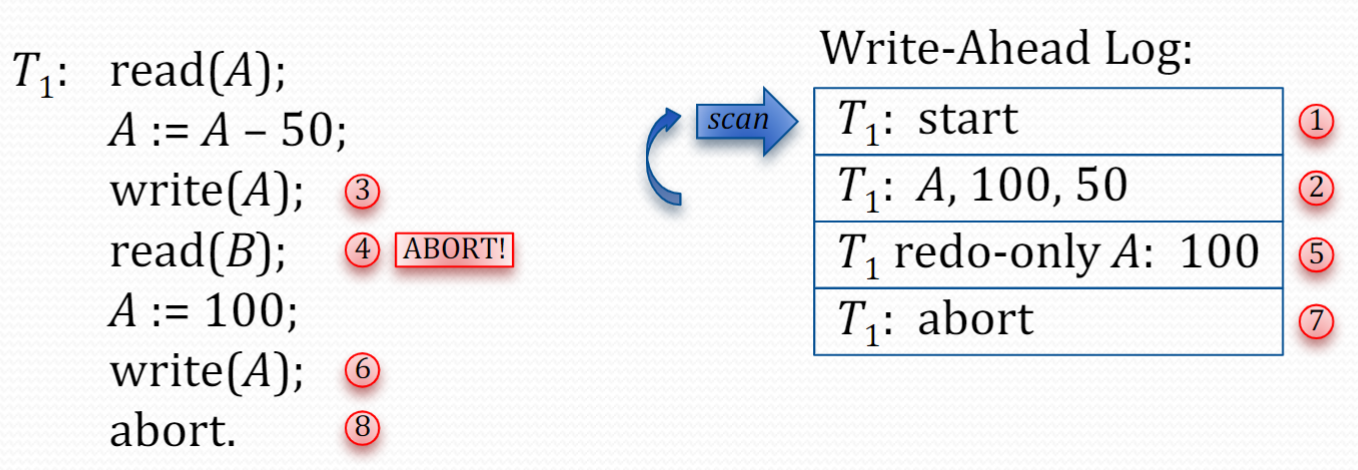
由于每个 WAL record (except START) 都包含 PrevLSN 字段,所以反向遍历效率很高
具体的 record 布局可以参考 edu.caltech.nanodb.storage.writeahead,此处不再赘述
有两个辅助函数完成了核心工作
-
applyUndoAndGenRedoOnlyData- 将 undo data (old version of the data) 应用到 page 中
- 并根据 undo data 生成 redo-only update record 的 data segments
- 注意这里 redo-only 的含义是仅在 redo 阶段考虑的 record
-
writeRedoOnlyUpdatePageRecord- 写入 redo-only update record
- 实际上写入的就是 update record 中的 undo data
注意区分 WALManager 中的 nextLSN 字段和 TransactionState 中的 lastLSN 字段,在同步的情形下 lastLSN 即为 nextLSN 的前一个 LSN
另外也需要区分 WALManager 中的 nextLSN 字段和持久化在 txnstate.dat 中的 nextLSN 字段,在 WAL 没有落盘的情况下,前者有可能大于后者
Step 6: Implement Redo and Undo Processing
Redo Processing
流程可以参考
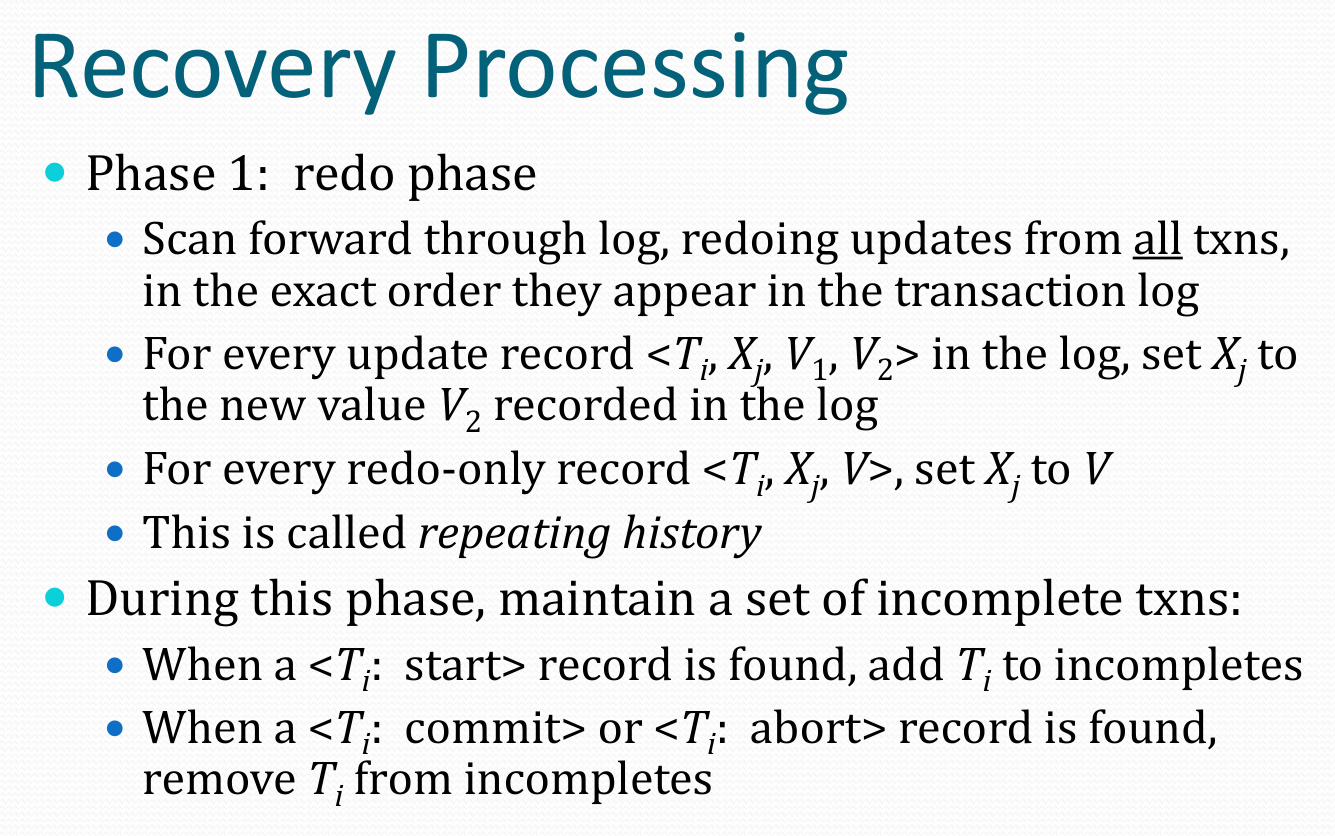
使用辅助函数 applyRedo 将 redo data (new version of the data) 应用到 page 中
有两个要点
- 及时移动
walReader的 offset - 使用
currLSN及时更新transactionID对应的recoveryInfo,这在后面的 undo process 中会使用到
Undo Processing
流程可以参考
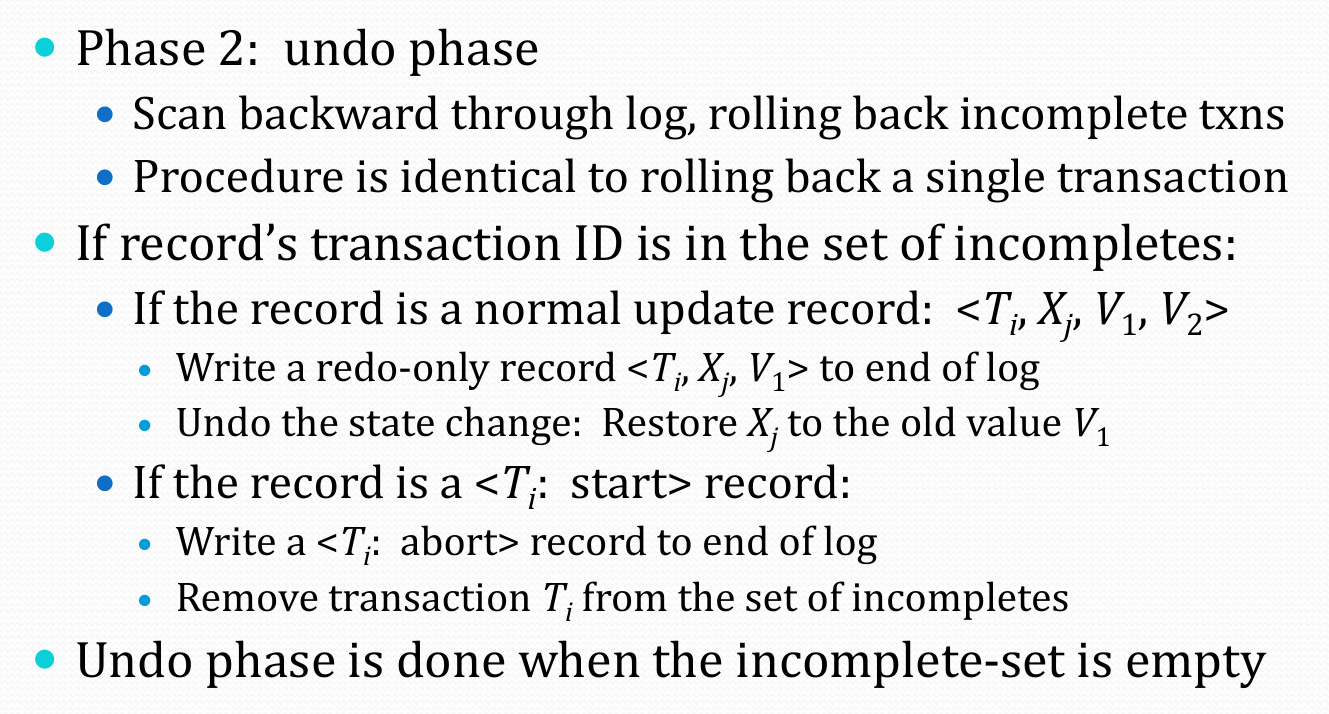
思路类似 rollbackTransaction,有两处不同
- 不考虑
UPDATE_PAGE_REDO_ONLY类型的 record - 在写入新的 record 时,使用的
transactionID和prevLSN需要从recoveryInfo中获得
简单的分析一下流程
- 从
nextLSN开始反向遍历- 当遇到跨 file 的情形时,利用
OFFSET_PREV_FILE_END字段
- 当遇到跨 file 的情形时,利用
- 获取每个 record 的 transactionID
- 若该 transactionID 属于 incompletes,则根据 record 类型进行处理
UPDATE_PAGE- 需要写入一个UPDATE_PAGE_REDO_ONLY类型的 record,其prevLSN为该 txn 的lastLSN,由于 WAL 中可能存在多个 txn 交错的情形,所以需要显式的记录,在写入完成后,还需要更新该 txn 的lastLSNSTART_TXN- 不再赘述
txn 交错的情形可以参考下图

Step 7: Testing
schemas/writeahead/basic-tests.sql 中有一些基础的测试用例
其中 2B 和 2C 完全相同
参考实验指南,以相同形式给出如下测试用例
1
-- TODO: INIT
CRASH;
-- TODO: RESTART NANODB2
-- TODO: INIT
CREATE TABLE testwal ( a INTEGER, b VARCHAR(30), c FLOAT);
INSERT INTO testwal VALUES (1, 'abc', 1.2);INSERT INTO testwal VALUES (2, 'defghi', -3.6);
SELECT * FROM testwal; -- Should list both records
CRASH;
-- TODO: RESTART NANODB
SELECT * FROM testwal; -- Should list both records
CRASH;
-- TODO: RESTART NANODB3
-- TODO: INIT
CREATE TABLE testwal ( a INTEGER, b VARCHAR(30), c FLOAT);
BEGIN;
INSERT INTO testwal VALUES (1, 'abc', 1.2);INSERT INTO testwal VALUES (2, 'defghi', -3.6);
SELECT * FROM testwal; -- Should list both records
COMMIT;
SELECT * FROM testwal; -- Should list both records
CRASH;
-- TODO: RESTART NANODB
SELECT * FROM testwal; -- Should list both records
CRASH;
-- TODO: RESTART NANODB4
-- TODO: INIT
CREATE TABLE testwal ( a INTEGER, b VARCHAR(30), c FLOAT);
INSERT INTO testwal VALUES (1, 'abc', 1.2);
BEGIN;
INSERT INTO testwal VALUES (2, 'defghi', -3.6);
SELECT * FROM testwal;
ROLLBACK;
SELECT * FROM testwal;
CRASH;
-- TODO: RESTART NANODB
SELECT * FROM testwal;
CRASH;
-- TODO: RESTART NANODB5
-- TODO: INIT
CREATE TABLE testwal ( a INTEGER, b VARCHAR(30), c FLOAT);
INSERT INTO testwal VALUES (1, 'abc', 1.2);
BEGIN;
INSERT INTO testwal VALUES (2, 'defghi', -3.6);
SELECT * FROM testwal;
-- FLUSH;CRASH;
-- TODO: RESTART NANODB
SELECT * FROM testwal;
CRASH;
-- TODO: RESTART NANODB6
-- TODO: INIT
CREATE TABLE testwal ( a INTEGER, b VARCHAR(30), c FLOAT);
BEGIN;INSERT INTO testwal VALUES (1, 'abc', 1.2);COMMIT;
BEGIN;INSERT INTO testwal VALUES (2, 'defghi', -3.6);ROLLBACK;
BEGIN;INSERT INTO testwal VALUES (-1, 'zxywvu', 78.2);COMMIT;
CRASH;
-- TODO: RESTART NANODB
SELECT * FROM testwal;CRASH;
-- TODO: RESTART NANODB7
-- TODO: INIT
CREATE TABLE testwal ( a INTEGER, b VARCHAR(30), c FLOAT);
BEGIN;INSERT INTO testwal VALUES (1, 'abc', 1.2);COMMIT;
BEGIN;INSERT INTO testwal VALUES (2, 'defghi', -3.6);ROLLBACK;
BEGIN;INSERT INTO testwal VALUES (-1, 'zxywvu', 78.2);ROLLBACK;
CRASH;
-- TODO: RESTART NANODB
SELECT * FROM testwal;CRASH;
-- TODO: RESTART NANODB将测试点归类如下
- 显式和隐式 txn
- rollback
- txn 未结束之前 crash
- crash 之前 flush,从而测试 recovery 过程是否能够处理不完整的 txn
- 多次 restart,验证后续的 restart 为 no-op
另外,在测试中发现了一个问题,由于关闭了 flushAfterCmd,对于每条 insert 语句,实际上落盘的是对应的 WAL,而非具体的数据
当 restart 时,会在 recovery 过程 redo 这些 update record,即写入对应的 data page
然而这里的写入并不会给对应的 data page 设置 pageLSN
回忆之前 insert 设置的
pageLSN作为非持久化数据,在 restart 后已经丢失
又因为这些 data page 已经 dirty 了,所以在 beforeWriteDirtyPages 中会出现 HEAP_TUPLE_FILE 或 BTREE_TUPLE_FILE 缺失 LSN 的情形
所以考虑将 throw exception 降级为 log warning
Analysis
这里为了配合 ARIES Recovery 算法,buffer pool 的策略是 STEAL / NO-FORCE,即
- 允许将未提交事务的改动刷盘
- 不要求在事务提交时把该事务的所有改动刷盘
前者在代码中的体现较少,后者的一个例子就是上面测试中发现的问题,即已经 commit 了,但是数据并未落盘,而是在重启后 recovery 的过程落盘
下面分析一下 WAL 协议在代码中的体现,即
- 必须保证所有 page 刷盘之前与它有关的所有 log 已经刷盘
- 必须保证事务提交前该事务的所有 log 已经刷盘
对于前者,data page 存在 pageLSN 字段,在 writeUpdatePageRecord 和 writeRedoOnlyUpdatePageRecord 中均会设置该字段,而在 beforeWriteDirtyPages 中会根据该字段调用 forceWAL
在设置该字段后,总是会调用对应 page 的
syncOldPageData方法,以保证每个 record reflects the changes since the previous “update” record
对于后者,在 commitTransaction 中,会以内存中的 nextLSN 为参数调用 forceWAL
另外一个值得注意的点是 record 的跨 file 问题,LSN 的计算是通过 computeNextLSN 完成的,当 offset 超出阈值时,就会切换到下一个 WAL,实际上存储的内容已经超出了阈值,但可以保证最后一个 record 总是完整的
Challenges
前置条件是 lab 1.3,即优化存储性能
对应的数据集为 TPC-H Homepage